14. ATTEMPTS AT RECOVERY (THE 1920s)

POST-WAR PEACE
CONTENTS
 The brutal reality facing a post-war The brutal reality facing a post-war
Europe
 Nationalism versus internationalism Nationalism versus internationalism
 The Russian Civil War (1917-1922) The Russian Civil War (1917-1922)
 The German Weimar Republic The German Weimar Republic
 The post-war treaties The post-war treaties
 The League of Nations The League of Nations
 The Polish-Soviet War (1919-1921) The Polish-Soviet War (1919-1921)
 The Greco-Turkish War (1919-1922) The Greco-Turkish War (1919-1922)
The textual material on page below is drawn directly from my work
A Moral History of Western Society © 2024, Volume Two, pages 97-108.
THE BRUTAL REALITY FACING A POST-WAR EUROPE |
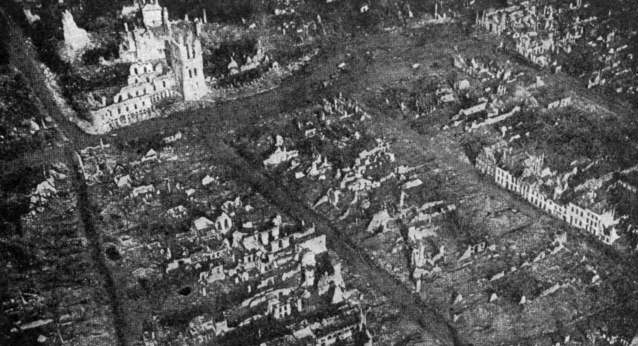
Ypres, Belgium, after the
Battle of the Lys
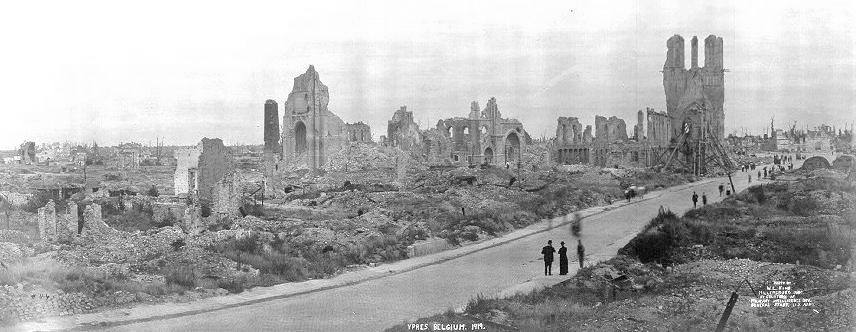 Ypres, Belgium, at War's
end - 1919
Ypres, Belgium, at War's
end - 1919
 Passchendael - before and
after the War
Passchendael - before and
after the War
Imperial War
Museum

The Town Square, Arras, France.
February, 1919.
National Archives
NATIONALISM VERSUS INTERNATIONALISM |
Four
empires – Russian, German, Austrian and Turkish – had completely
disappeared because of the four-year bloodletting. And what
replaced them was hardly an immediate advance forward in peace and
prosperity of the nations involved. Chaos, not peace and
prosperity under new progressive governments, was what greeted the
people with the loss of their former autocratic governments.
As
for the League of Nations ... it had virtually no impact on the way any
of these major crises played out. As a protector of the
international peace it proved itself to be completely useless.
Almost all of what developed did so as a matter of direct intervention
by a number of national powers who conducted their diplomacy in
accordance with their own respective national interests.
This would be a sign of things to come. Maybe it will always be
this way, despite the dreams of those who still look for some kind of
transcending principle or organization that they believe might finally
act in service to a higher sense of international order.
|
The Russian Civil War (1917-1922)
The worst case of post-war choas was that of Russia, which fell into a four-year civil
war that destroyed more Russian life than had the European war
itself. Armies of Whites (a scattered coalition of supporters of
Kerensky’s Provisional Government, tsarists, Cossacks and an array of
various conservative groups) and Reds (Lenin and Trotsky’s Bolsheviks)
ranged back and forth across Russia, pillaging, slaughtering, and
burning farms and villages as they went, leaving behind pure desolation
as they passed through to another battle with their enemies. Also
involved were a number of foreign armies (British, American, Czech,
Japanese) sent to Russia to support the Whites in the hope of keeping
Russia in the war ... but who stayed on even after the war was over to
continue that support. Sadly, this participation of the foreign
troops on the side of the Whites gave the war the appearance among
Russians of the Bolsheviks fighting for the national rights of Russia
against the efforts of Whites to put Russia under foreign rule.
Adding to the confusion, a number of non-Russian national groups within
the Russian Empire saws this as an opportunity to break free from
Russian domination and establish national independence for themselves
(opening up local political contests among themselves in the
process). Thus the Russian Empire collapsed into a state of
bloody chaos.
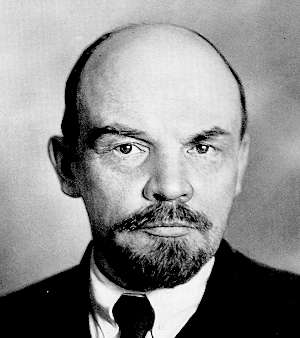 Lenin Lenin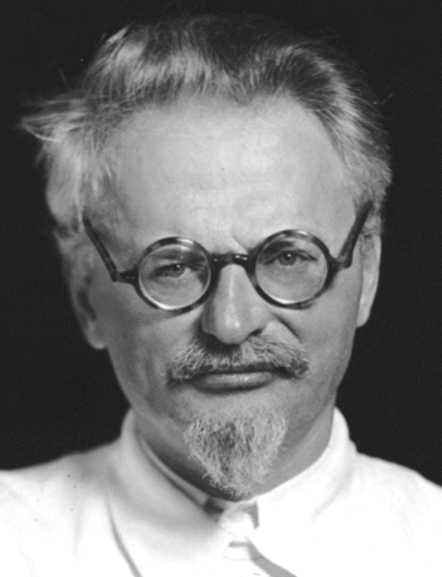 |
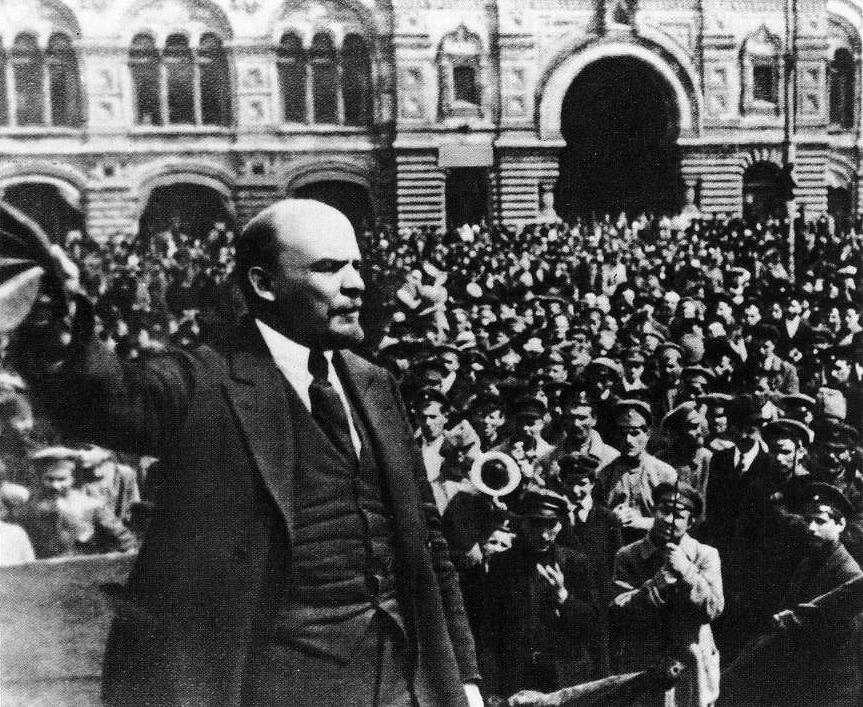 Lenin addressing a crowd
in newly renamed "Red Square" Moscow - 1919
Lenin addressing a crowd
in newly renamed "Red Square" Moscow - 1919
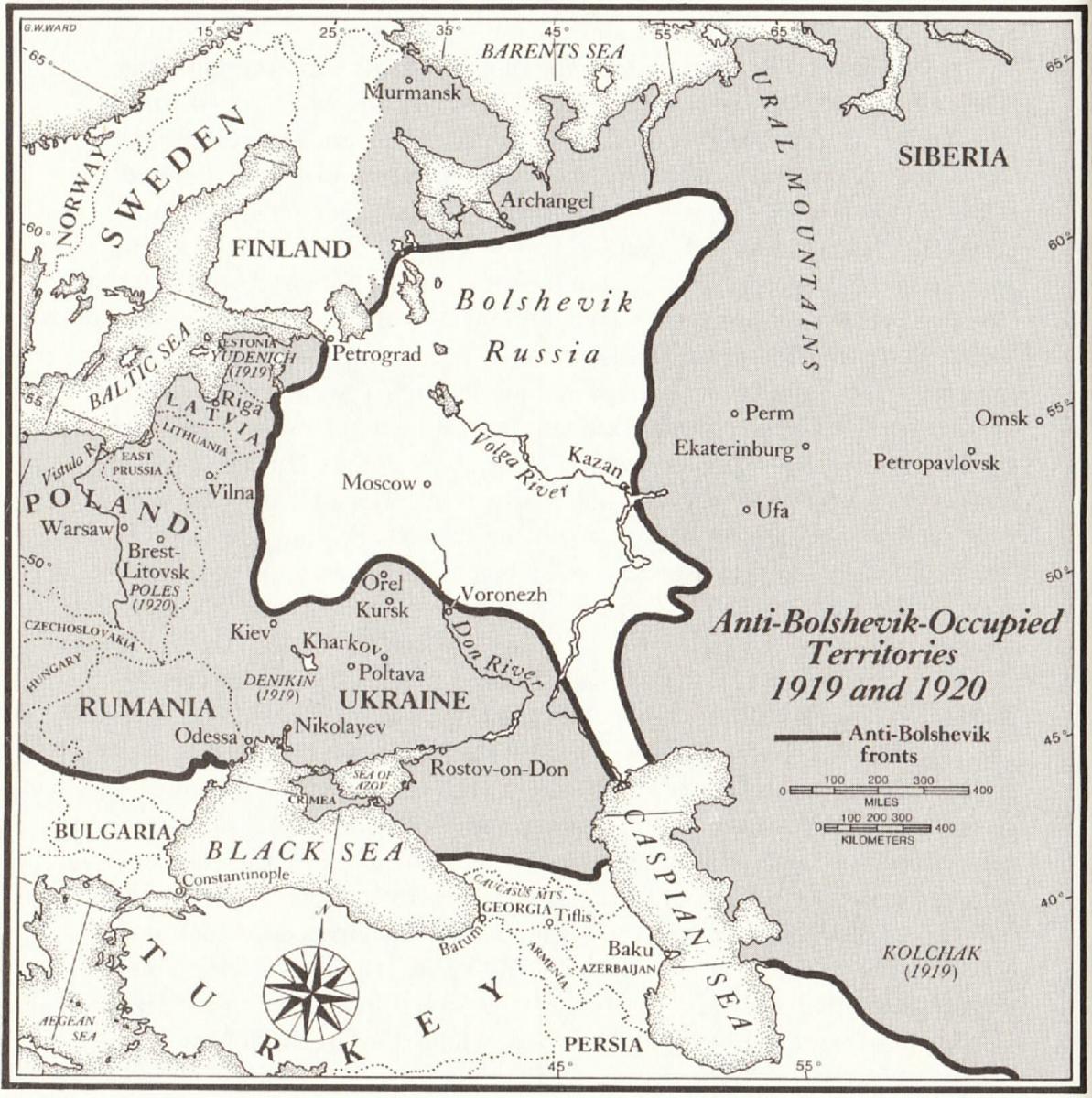 William Manchester, The
Last Lion: Winston Churchill, Visions of Glory, (Boston: Little, Brown
& Co., 1983), p. 678.
William Manchester, The
Last Lion: Winston Churchill, Visions of Glory, (Boston: Little, Brown
& Co., 1983), p. 678.
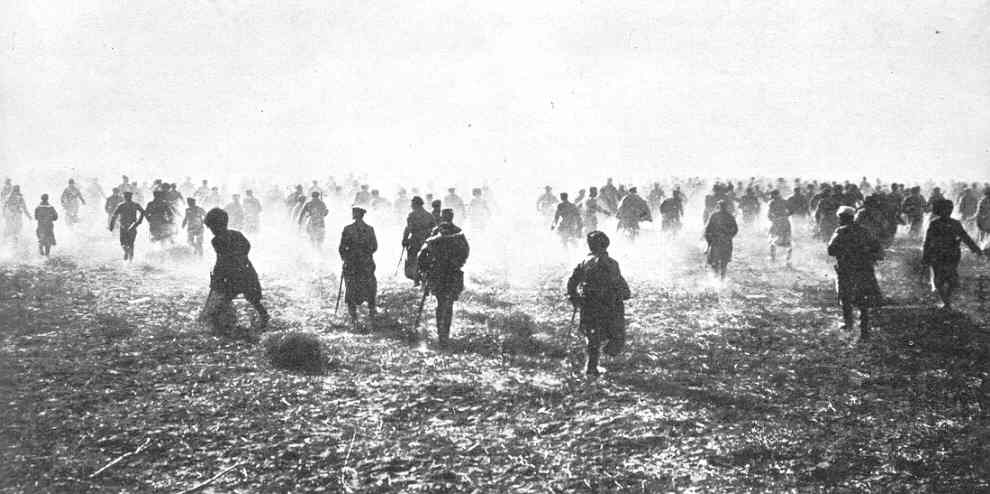
Red troops advancing against
the Whites in the Crimea - late 1919
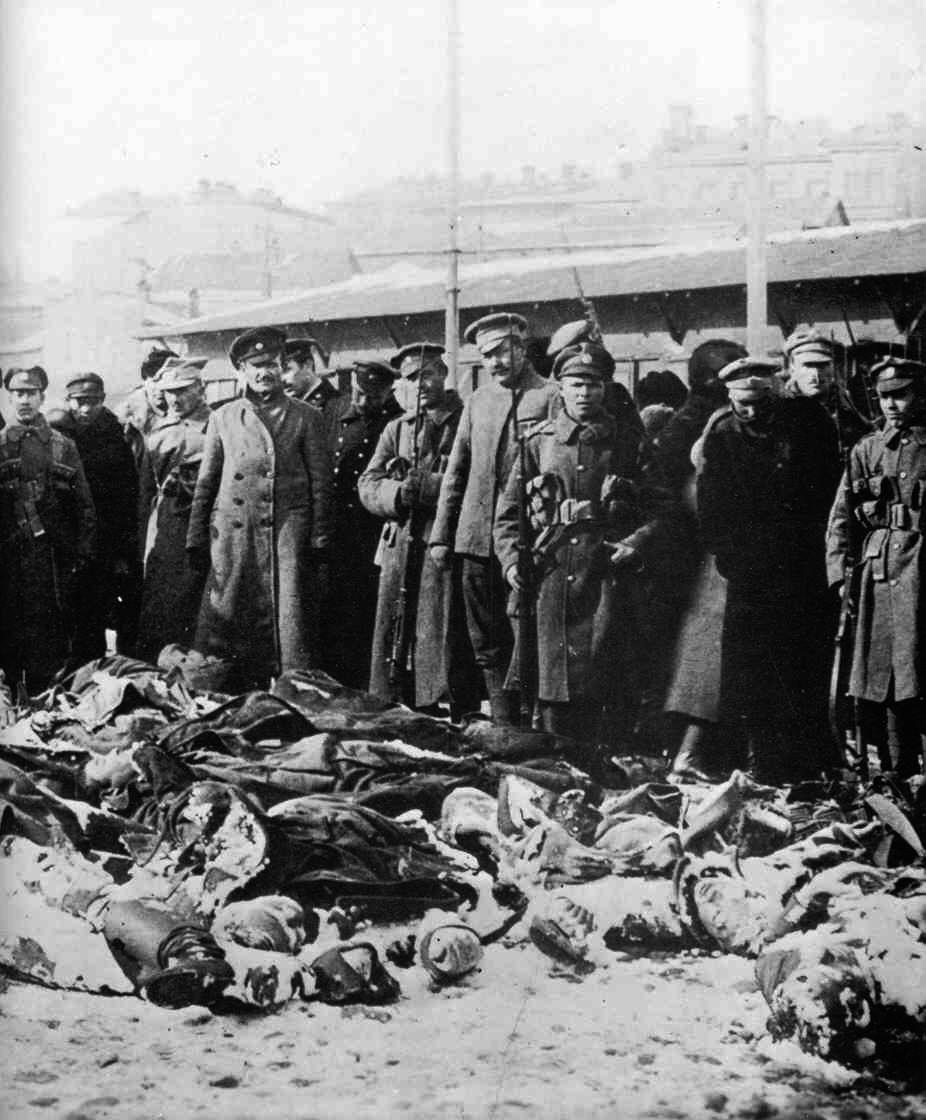
Russian White soldiers standing
over the bodies of dead Bolsheviks or Reds – 1919
 American troops in Arkangelsk – aiding the resupply of the White army.
American troops in Arkangelsk – aiding the resupply of the White army.
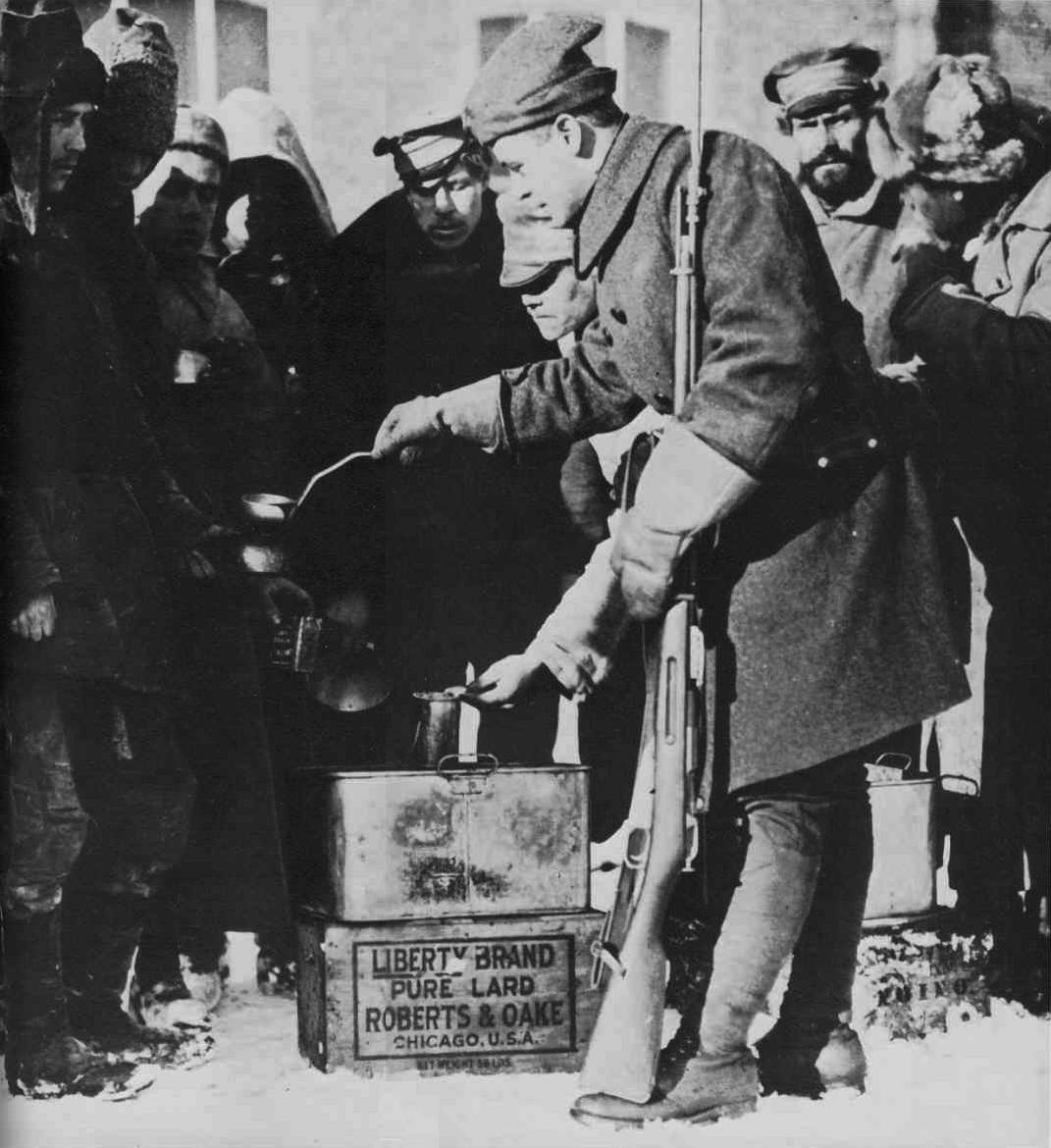
American soldier ladling
out soup to a Russian prisoner in Archangel
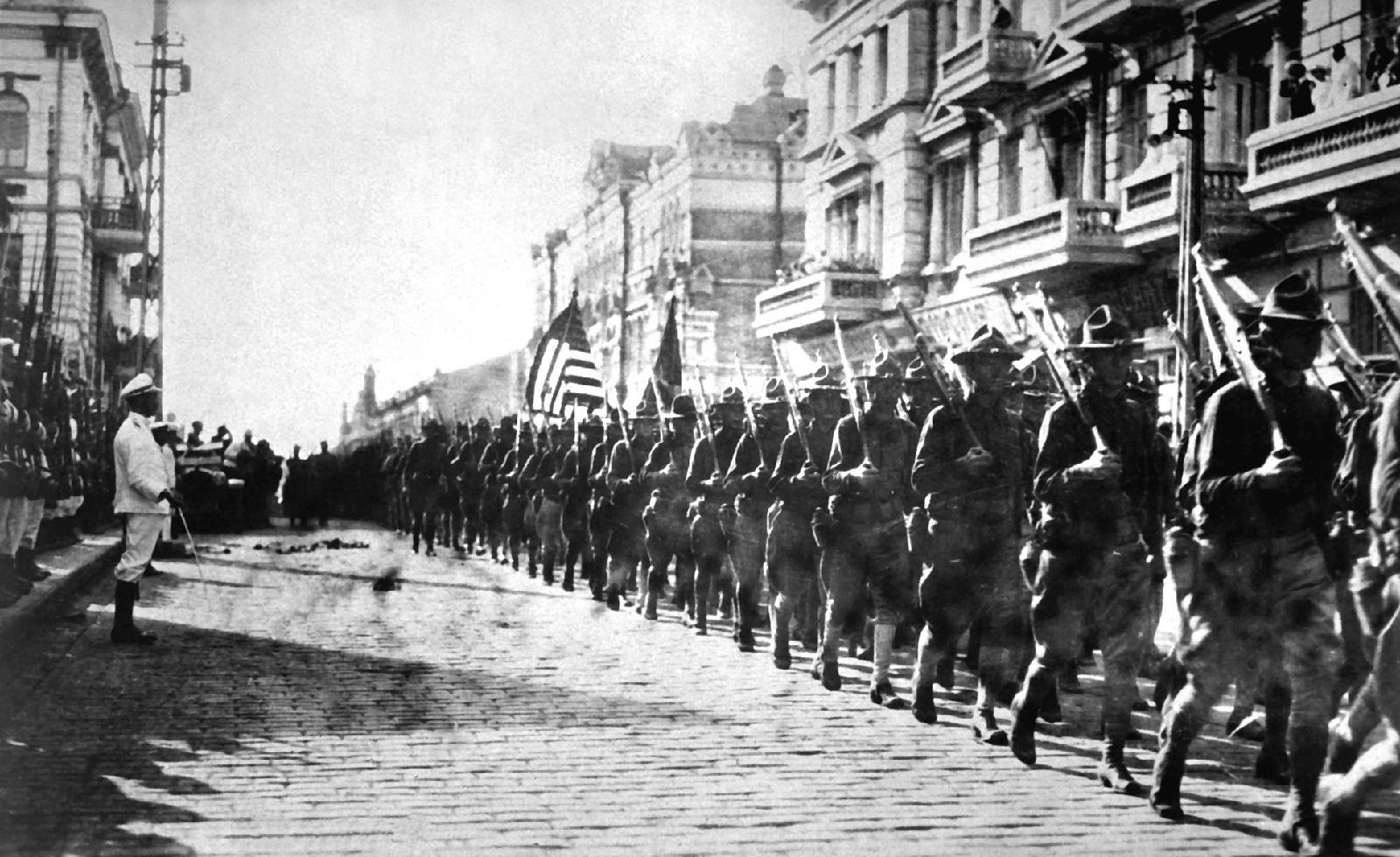
American troops in Vladivostok
on parade. Japanese marines are standing
to attention
as they march by. Siberia, August 1918

17 U.S. dead being brought
out of Romonofska, Siberia
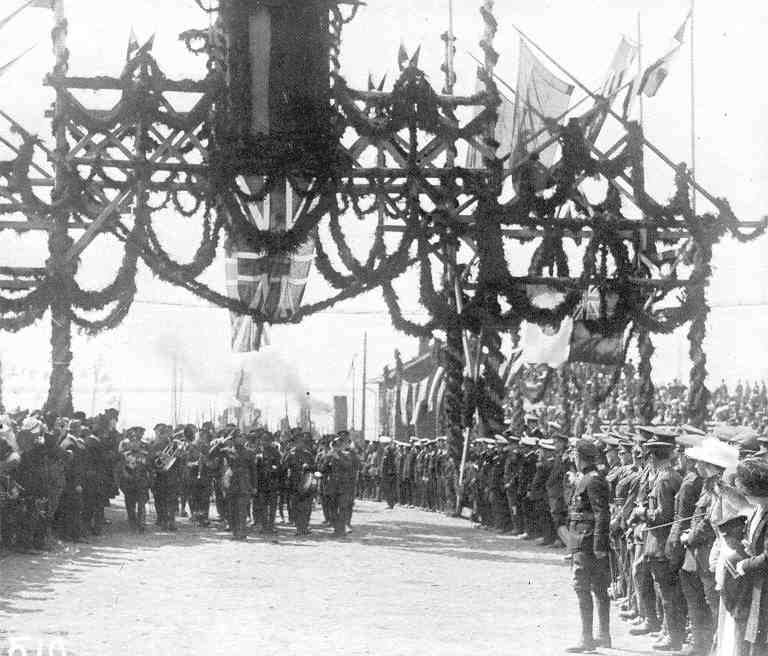 British troops arriving in
Arkangelsk to replace the American troops who will be going home – early
1919.
British troops arriving in
Arkangelsk to replace the American troops who will be going home – early
1919.
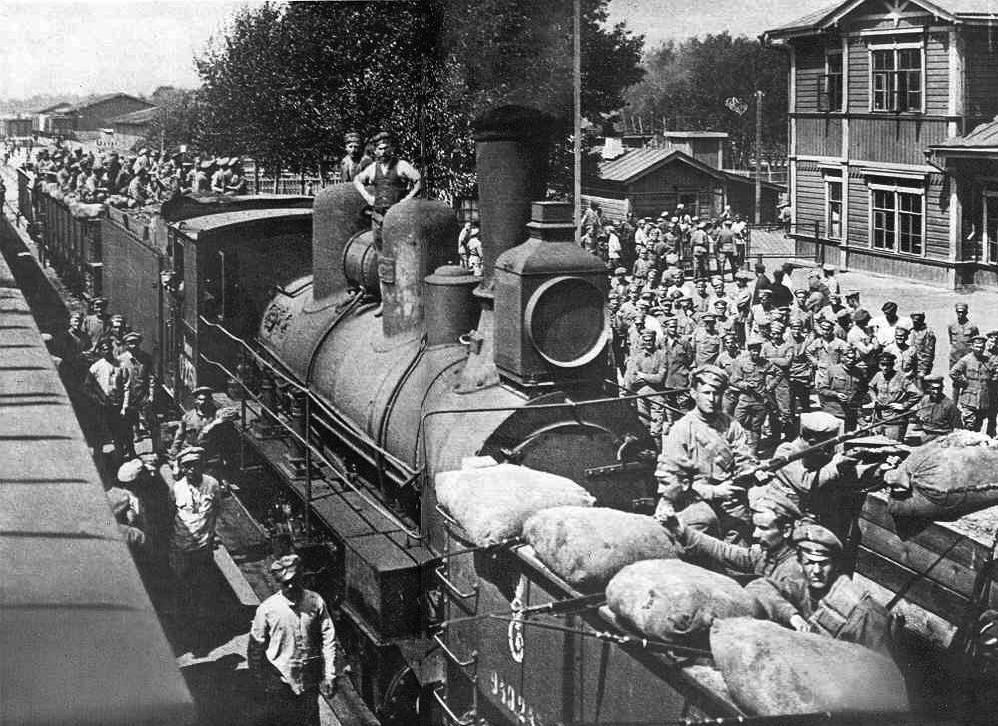
The Czech legion as it is
about to embark across Siberia in the hope of getting home – by sea.
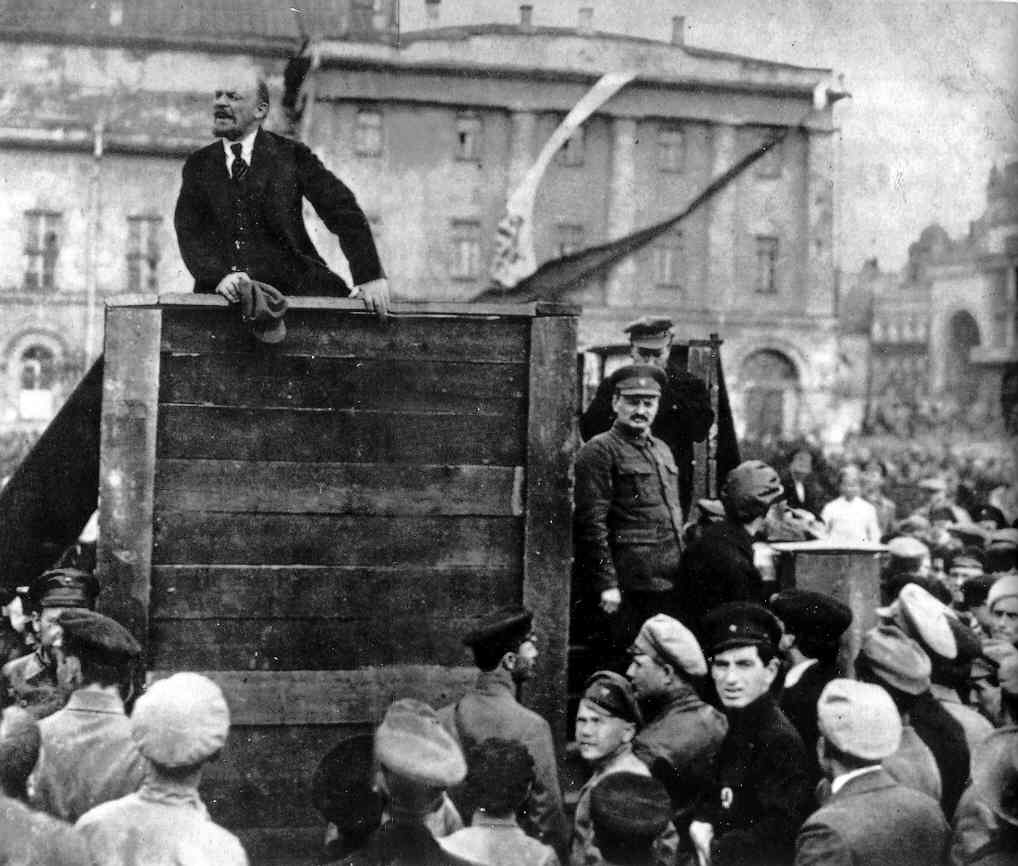
Lenin's call to arms in Moscow
against invading Poles – May 5, 1920
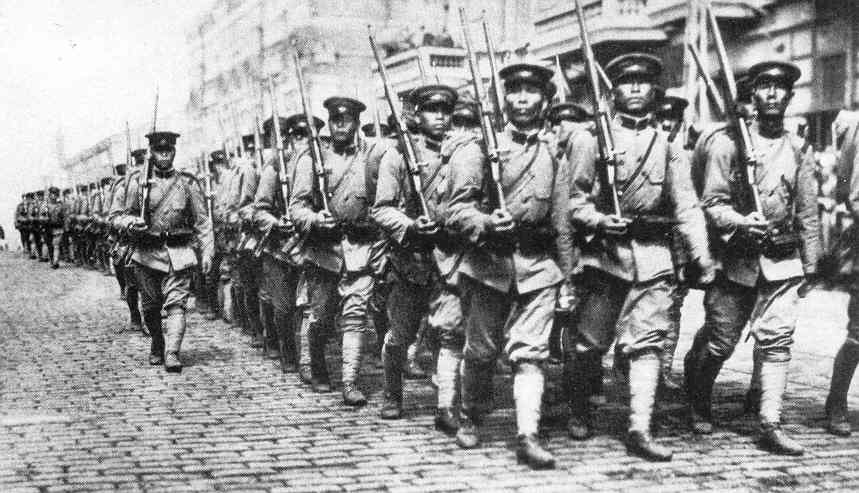 Anti-Bolshevik Japanese troops
in Vladivostok during the Russian Civil War – 1921
Anti-Bolshevik Japanese troops
in Vladivostok during the Russian Civil War – 1921
National Archives
|
Lenin's move to secure his Soviet social order
In the meantime, Lenin set about immediately to put into force a social
strategy he had worked out well beforehand. He decreed the
transfer of the large landholdings (including lands belonging to the
church) to the peasants who actually worked the farms ... not only
winning the hearts of the peasants, but stirring fear in their hearts
that if the Whites were to win the civil war the peasants would lose
title to their lands. Lenin also moved quickly to put large
industries under Bolshevik control, although workers’ committees were
set up to give the industrial workers a sense of ownership of the
production of these industries ... again, to win the loyalties of the
Russian working classes. Lenin also set up a bureaucracy of
Bolshevik agents who were sent out in the country to monitor these
changes. And finally, Trotsky was assigned the task of
professionalizing the Bolshevik army (the Red Army), reshaping it
quickly as an effective fighting force designed to protect the rights
of the common people against the former ruling classes ... a task in
which Trotsky succeeded brilliantly.
Lenin also moved quickly and ruthlessly to eliminate all members of the
social classes (the nobility and the bourgeoisie or middle class that
had not yet fled Russia) most likely to oppose his revolution.
Even peasants considered to be suspicious of anti-revolutionary
loyalties were executed or exiled to Siberia. All political
parties other than the Bolsheviks were outlawed and the Russian press
was brought into conformity with the Bolshevik revolution ... or shut
down completely. The Cheka, a secret police (modeled after the
Tsarist secret police), was created to remove outspoken opponents of
the new regime.1 And finally, on July 18, 1918, the Tsar and his
family were executed out of fear that they might fall into the hands of
an advancing White army.
The Orthodox Church and the Christian faith also became objects of
Lenin’s social revolution. The church had long been supporters of
the Russian autocracy and thus according to Lenin’s logic needed to be
destroyed. But he was also opposed to the Christian faith itself,
held dearly in the hearts of most Russians, for he feared that it
harbored conservative attitudes that would stand in the way of the
cultivation of a revolutionary conscience among the new class of
proletarian comrades foundational to Lenin’s rising social order.
Ultimately, little by little Trotsky’s Red Army was able to gain ground
against the less well-organized White Armies. Kolchak’s White
army, at first successful in Siberia, was finally defeated by the Reds,
as was a coalition of Whites in Ukraine (1919-1920). Remnants
held out in the south until finally driven out of Crimea in late
1920. In October of 1922 the Reds were able to secure all of
Siberia when the Japanese pulled out of the far eastern region and the
last White army in Siberia at Vladivostok surrendered. From
that point on only small scattered groups of Whites continued the
struggle. Thus Lenin had finally secured his Soviet state.
But things were not going quite as well for Lenin as he had hoped for
in those first years of the establishment of the Soviet state.
The economic disruption of the civil war was immense. Industrial
production dropped to one-fifth the level it had stood at in 1913
before the European war. Towns were deserted as workers fled to
the countryside in the search for food. Even production on the
farms was less than half what it had been before the war. There
was no stable currency the farmers could count on or even manufactured
good they might want to buy, so most farmers reduced their food
production to levels sufficient merely to feed their own
families. By 1920 widespread malnourishment and disease was
rampant in the country, claiming hundreds of thousands of lives.
1Since
opponents of Lenin’s regime were arrested secretly (usually in the
middle of the night) no numbers were kept of the people "liquidated"
(usually killed directly) by the Cheka. Estimates vary from 50
thousand to hundreds of thousands. So bad was its reputation that
in 1921 its name was changed to the Government Political Office (GPU)
... as if a name change might improve the reputation of the Leninist
regime.
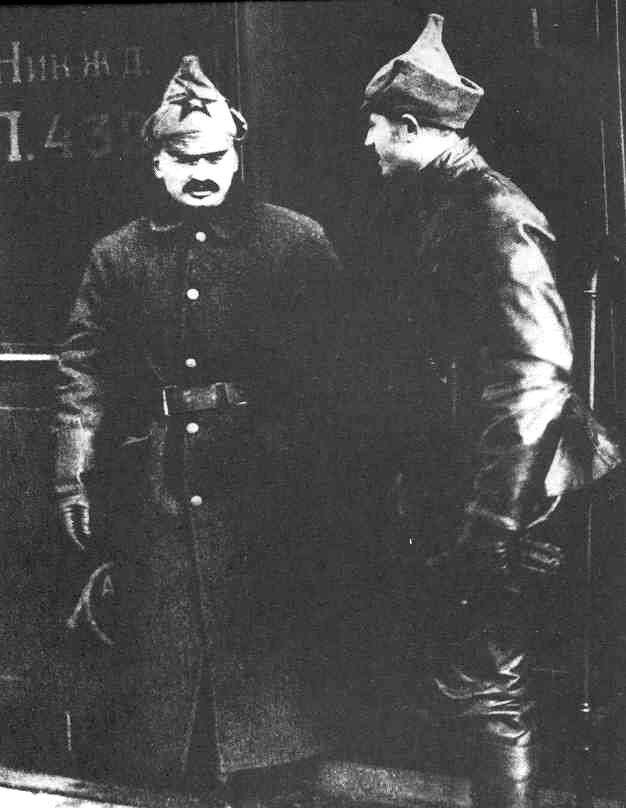
Leon Trotsky in
1921
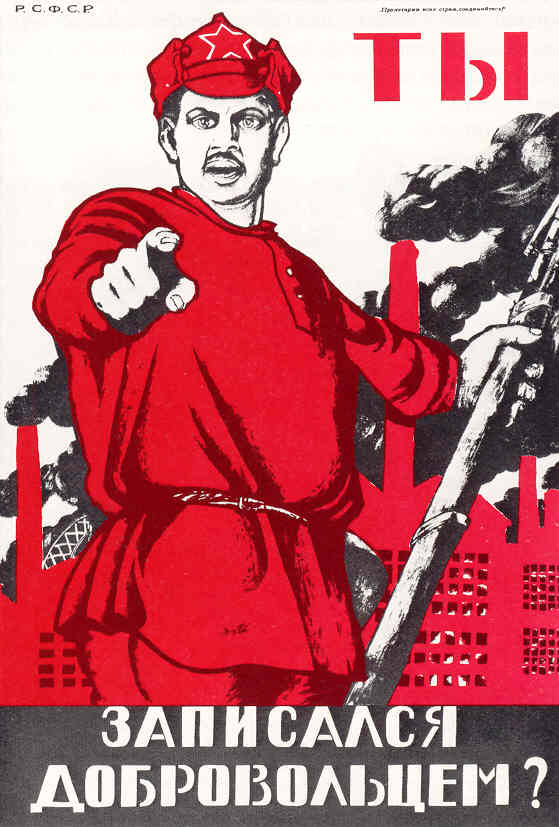 A Red Army recruiting
poster
A Red Army recruiting
poster
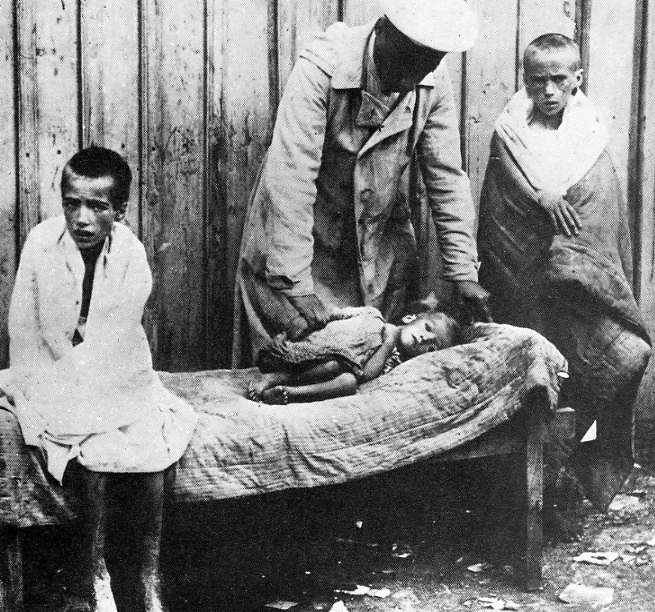 Starving children in
Russia
Starving children in
Russia
In the five years of the
Russian
civil war 15 million people lost their lives
- most of them hapless civilians.
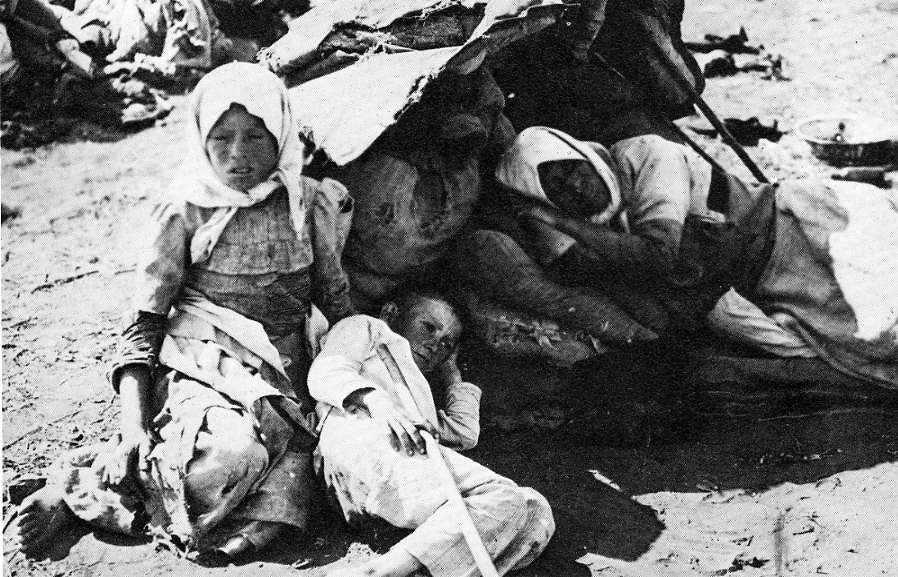
Starving Russians during
the drought of 1921
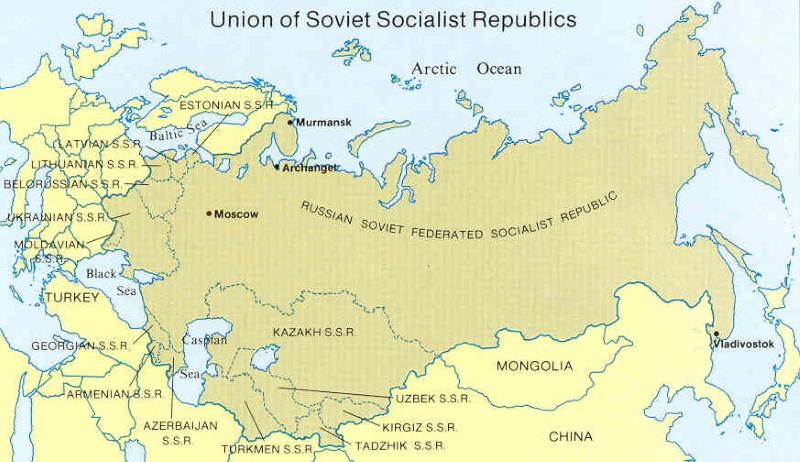
Lenin’s New Economic Policy (NEP)
By 1921 Lenin was ready to try another approach to industrial and
agricultural production. He came up with a plan termed the New
Economic Policy (NEP) which opened up the economy to the development of
small private enterprises and private trading beyond the official state
program. He put the rouble back into operation in order to
facilitate that trade. He established a standard agricultural tax
rather than the state requisitions of food products as payment to the
state. He did maintain the state monopoly on the major industries
however. Yet slowly the economy started signs of growth under the
NEP, especially in the realm of agriculture where the revival was
fairly quick. Even in the industrial sector, Russia was back up
to 1913 production levels by 1927.
However, Lenin would not live to see the fruit of his labors. His
work took its toll on his health, which began to show signs of decline
toward the end of 1921 ... and in May of 1922 he suffered a stroke
which partially paralyzed him. He largely recovered ... though
now he had to look to others to carry much of the work. Then in
early 1924 he died. Now would begin a struggle for power among
the party elite that would have a highly determinative effect on the
further development of the Russian Soviet Union.
|
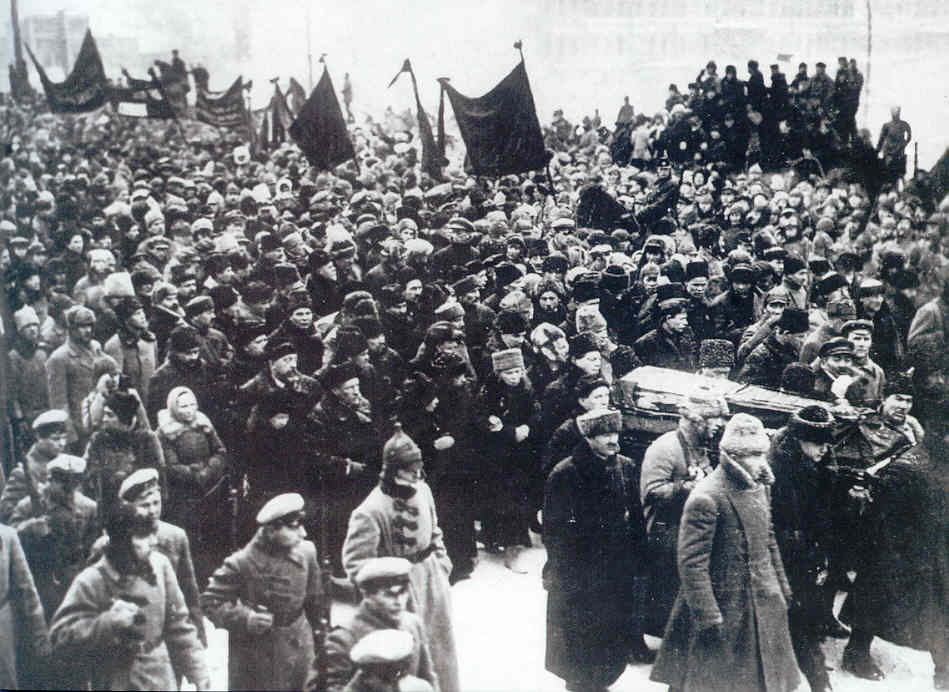
Funeral of V.I. Lenin -
1924
THE GERMAN WEIMAR REPUBLIC |
The
Germans themselves had not asked for a democracy or republican form of
government. It had been pushed on to them as a pre-condition
imposed by their enemies as the price required to secure the peace the
Germans so eagerly sought. To be sure there would be those
(mostly intellectuals of the Socialist variety) who supported the idea
of a German republic. But for most of the Germans this mattered
little. Eventually (the early 1930s) the Republic would be
considered even a bit treasonous because of its birth in what
increasingly came to be understood as a wartime betrayal of Germany.
Actually, very little changed about German society because of this
changeover to a republican government. Although the heads of the
various states making up the German union were gone, their
bureaucracies remained, conducting political business as usual in
Germany.
The street violence that sent Wilhelm into exile continued to mount,
giving opportunity (November 1918 to January 1919) to a group of
leftist radicals (the Sparticists, led by Karl Liebknecht and Rosa
Luxemburg) to attempt to spark a German revolution similar to
Lenin’s. But they ran into the stiff resistance of returning
soldiers who formed themselves into anti-socialist units (the Freikorps
or Free Corps) who went about gunning down radicals whenever they
gathered. A similar attempt to establish a Soviet Republic in
Bavaria (April-May 1919) was also taken out by the Freikorps.
Thus the only events resembling something of a real revolution in
Germany were quickly snuffed out.
Less radical Socialists quickly moved to fill the political void
created by the departure of Wilhelm. A Provisional Government was
quickly established and Friedrich Ebert, a Social Democrat, was made
its head. Elections were soon held (January 1919), in which a
number of parties (many makeovers of the parties of the days of
Imperial Germany) took their seats in the Reichstag, although the
Social Democrats were by far the largest. Ebert was elected as
the republic’s new President. Being concerned about how easily
urban mobs (Paris, Petrograd and now Berlin) were able to dominate
their nation’s politics he decided move the task of writing a new
constitution to the town of Weimar.
|
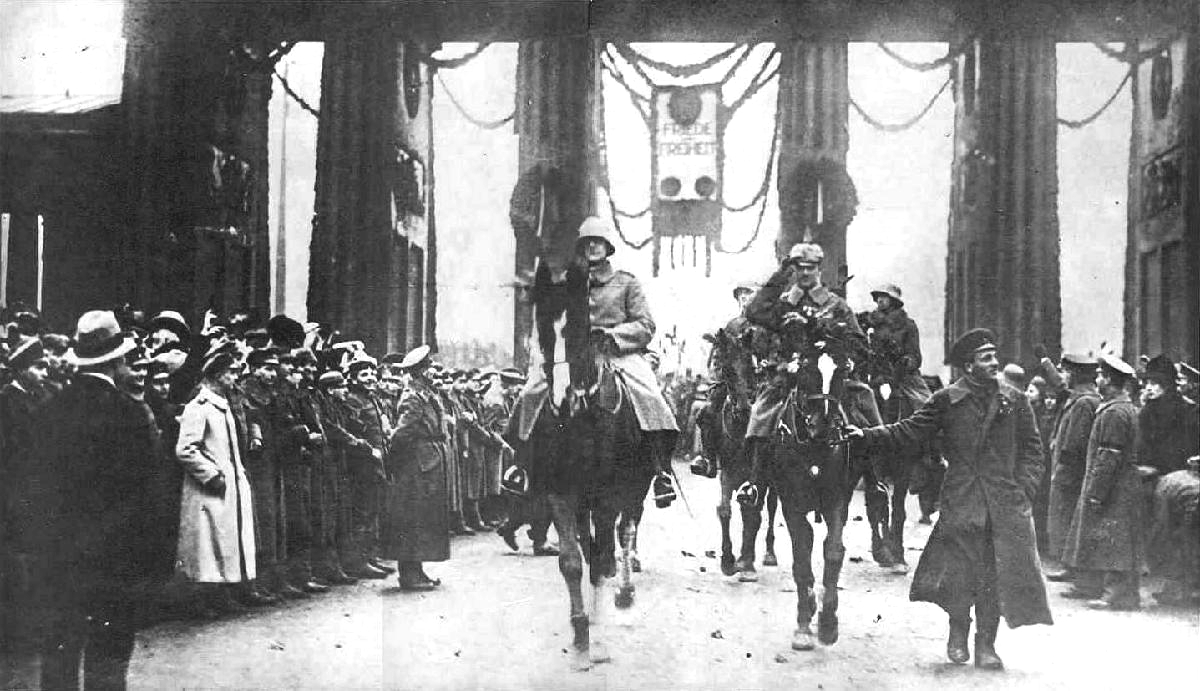
German troops marching home
from the war through the Brandenburg Gate victory arch
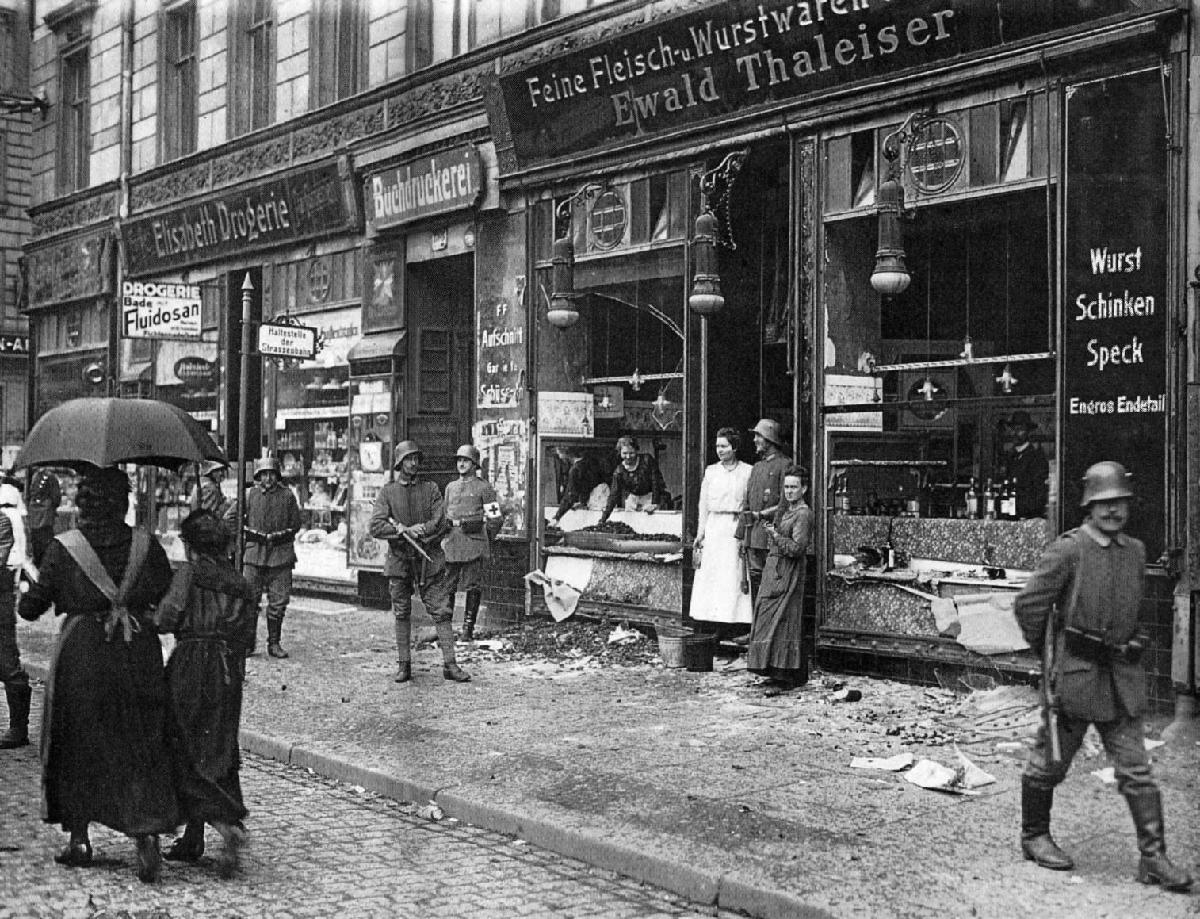
Smashed grocery store windows
in hungry Berlin - 1919
The "Sparticists" attempt
a Communist capture of post-war Germany
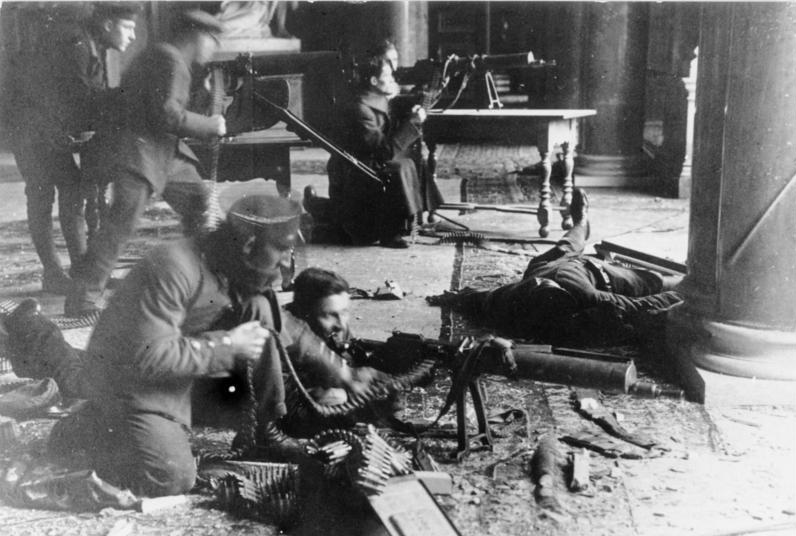 Leftist soldiers during Christmas
fights in the Berlin City Palace - December 1918
Leftist soldiers during Christmas
fights in the Berlin City Palace - December 1918
Deutsches
Bundesarchiv
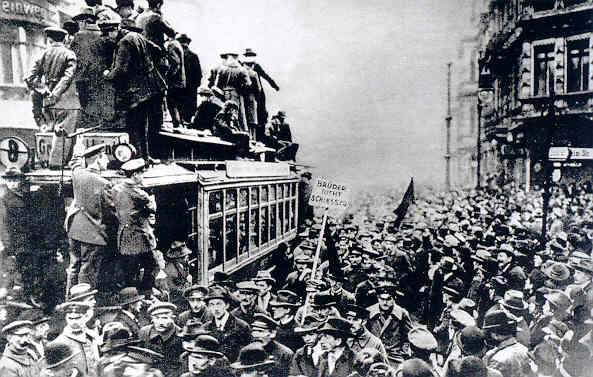 German Sparticists crowding
the streets of Berlin - January 1919
German Sparticists crowding
the streets of Berlin - January 1919
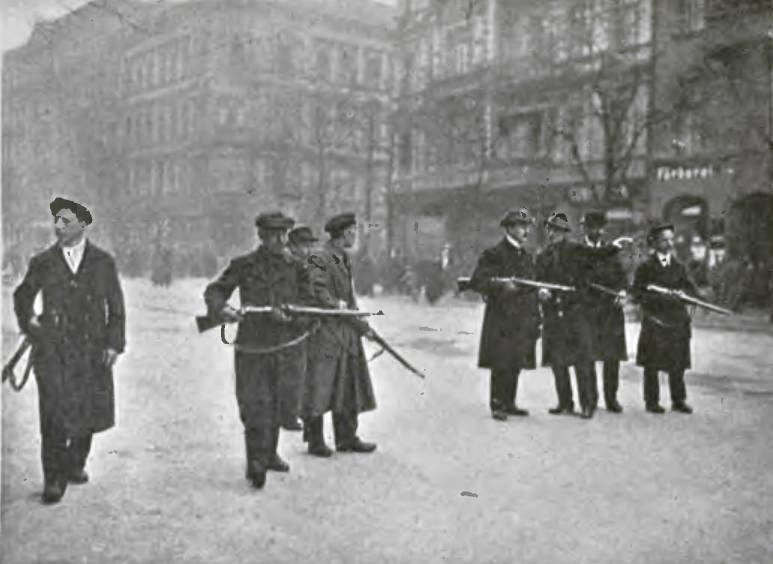 Sparticist militia in the streets of
Berlin
Sparticist militia in the streets of
Berlin
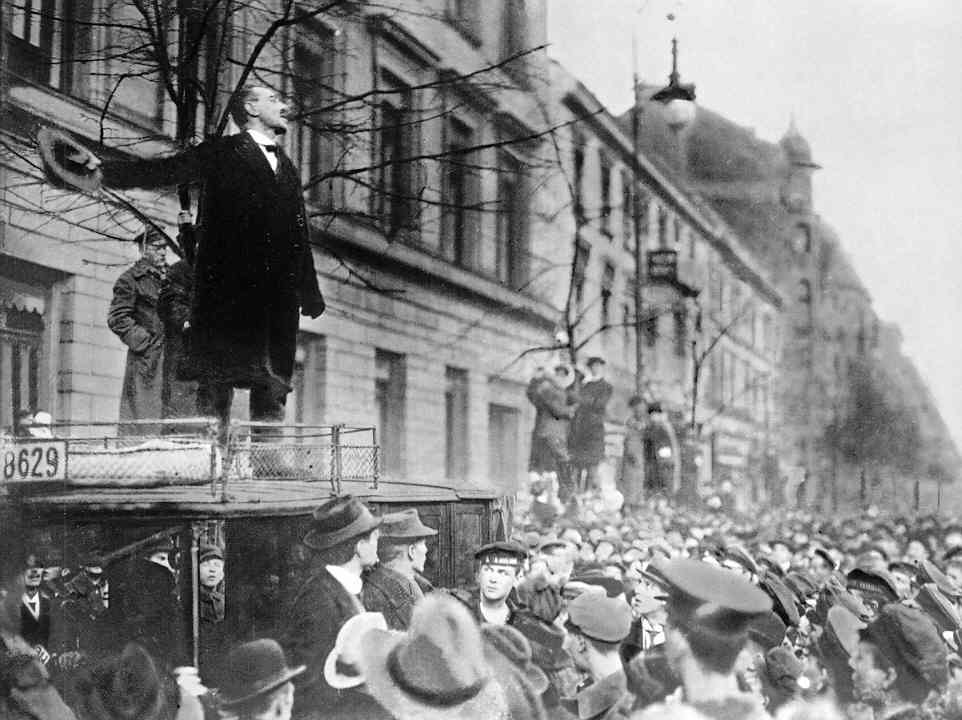
Karl Liebknecht addressing
a crowd of pro-Soviet or Communist Sparticists in Berlin (January 1919)
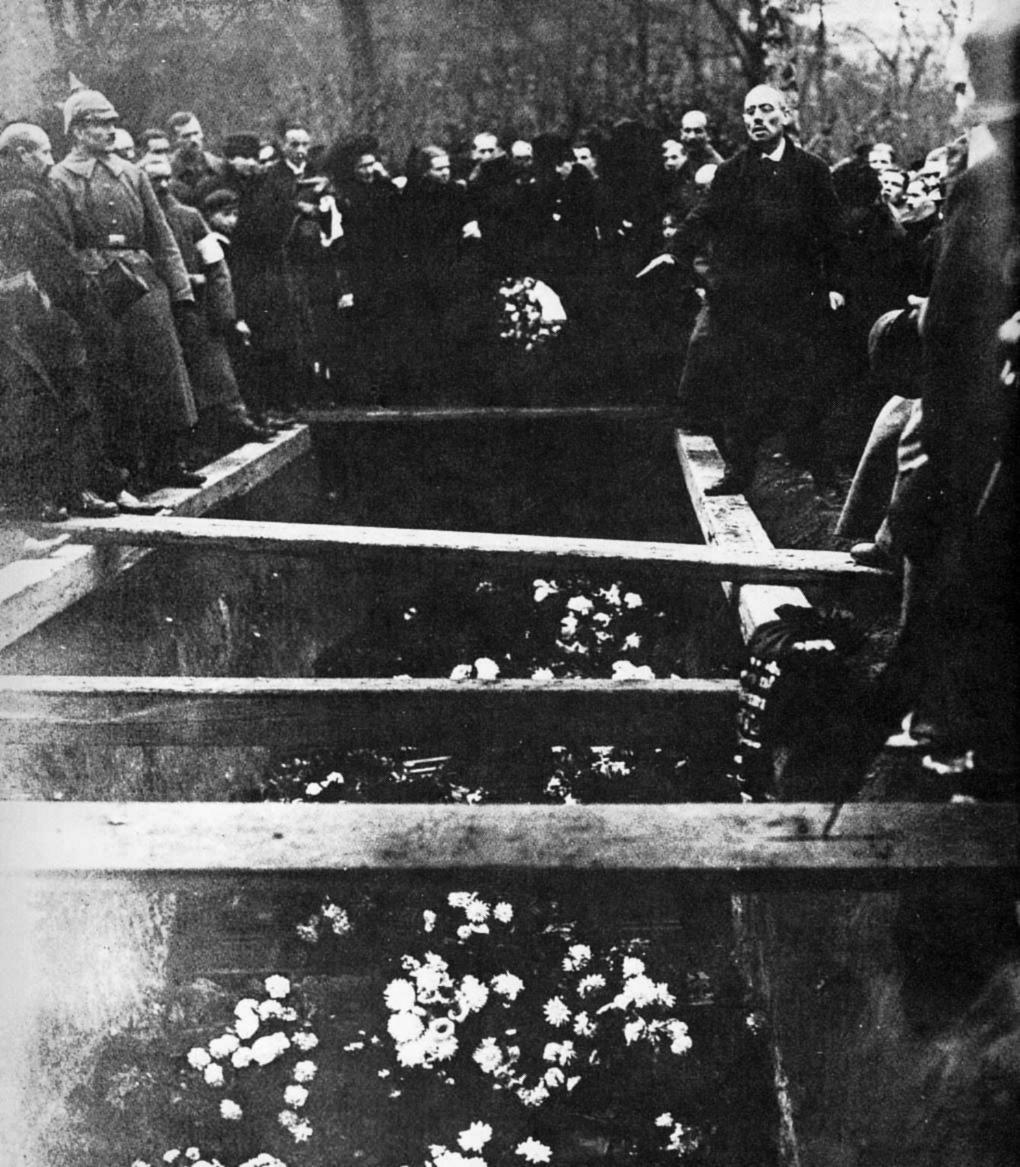
Karl Liebknecht at a funeral
of of followers killed by the Freikorps - January 1919
(he himself was assassinated
a few days later)
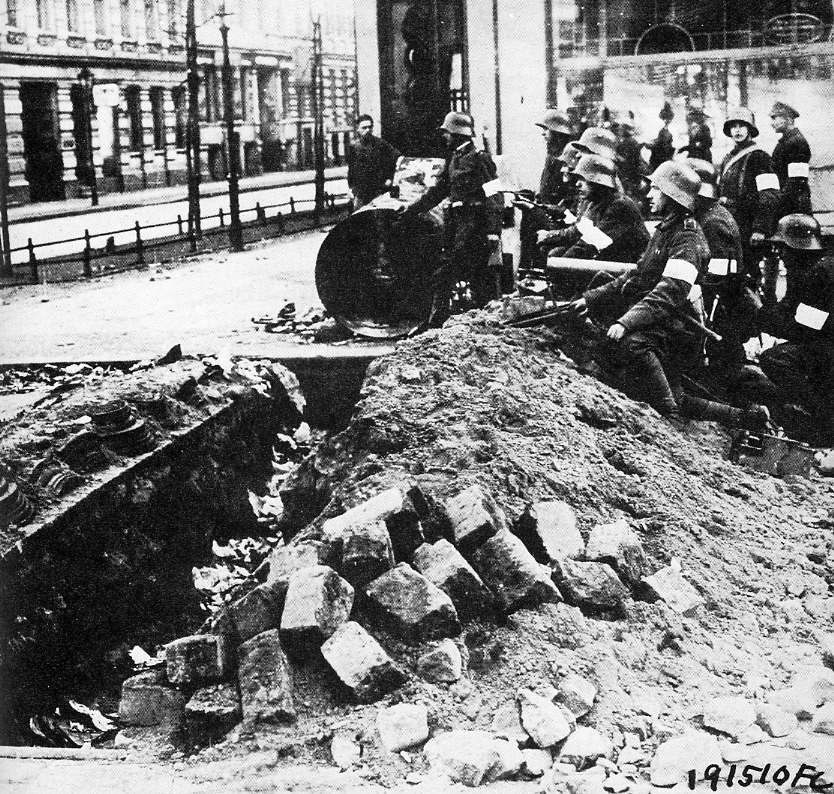
German Free Corpsman (member
of one of the Freikorps) at a Berlin street barricade
during the March
1919 Sparticist uprising
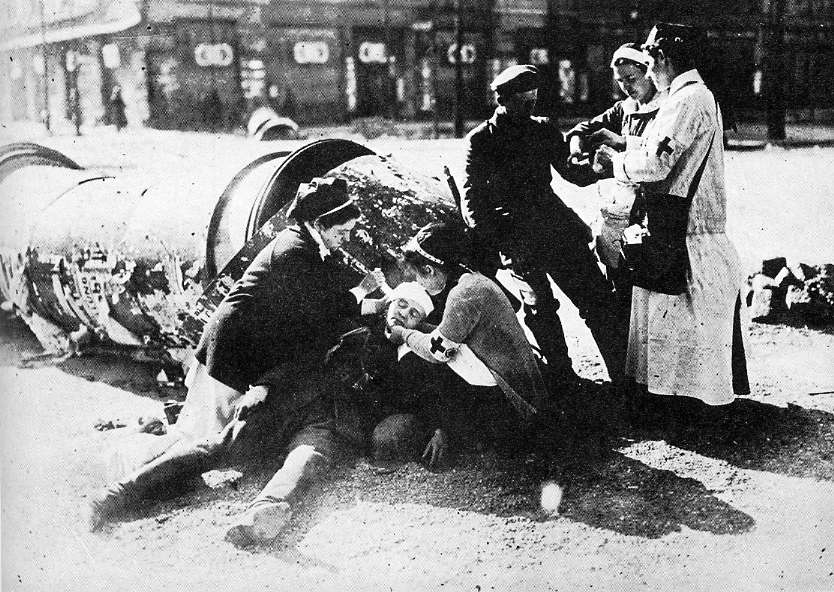 Nurses tending wounded German
Free Corpsmen - 1919
Nurses tending wounded German
Free Corpsmen - 1919
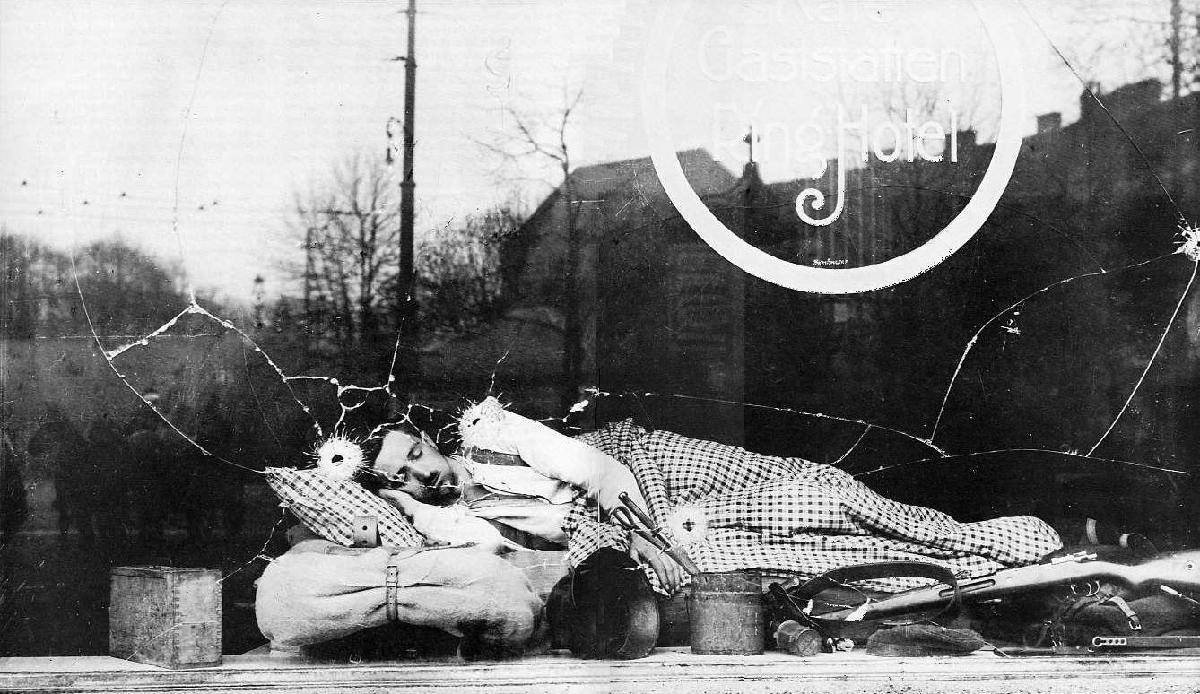
German Free Corpsman resting
- 1919
Foreign Records Seized,
1941, National Archives
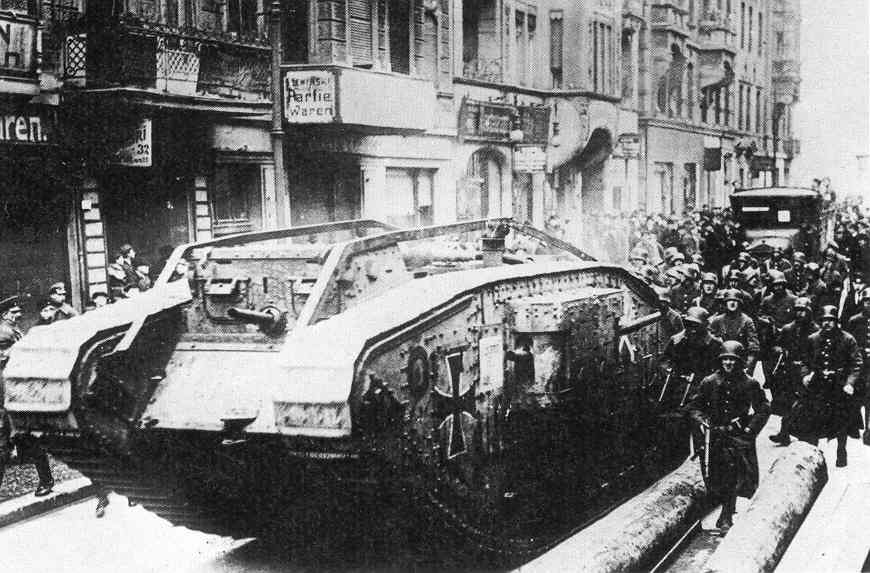
A converted British tank
put to German service in Berlin helping to crush the Communist
uprising there - January 1919
Library of
Congress
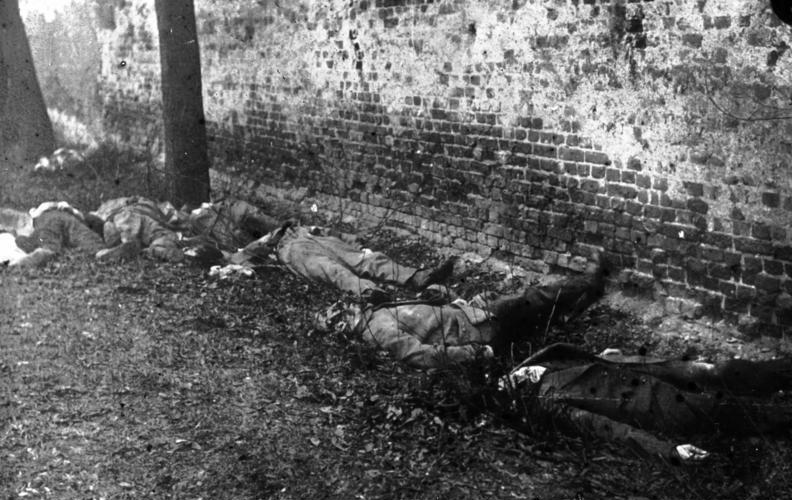 Berlin - Executed Sparticists - March
1919
Berlin - Executed Sparticists - March
1919
Deutsches
Bundesarchiv
Meanwhile
Germany was waiting to see what were going to be the exact terms
required of it in order to secure formally a new post-war peace.
They were harsh.
Wilson's (and Americas') grand disappointment. Wilson had himself traveled to Paris to ensure personally that his
promised Fourteen Points would be the terms by which the final peace
settlement with Germany was shaped. Upon his arrival in Europe he
was celebrated so wildly by the cheering crowds that he certainly
expected to be supervising the treaty negotiations from a position of
great strength. But his own idealism blinded him to the actual
social dynamic taking place. The Europeans were cheering him
because his American troops had seemingly tipped the balance of
military power in Europe so as to finally give the Allies their
long-sought victory. They saw in him their national victory ...
not some abstract idea of a new world of international peace and
understanding. Their sense of victory over a hated enemy was what
excited them. Years of slaughter, of destruction of homes and
villages, of wounded family and friends returning from the front, was
what filled their minds.
The European leaders responsible for negotiating a peace with Germany
understood what was expected of them. Their people wanted revenge
... not reconciliation and equity.
Sadly, Wilson at that point had nothing more to bring to the
negotiating table. America had played its part ... and had
departed, back to homes and towns unaffected by the war. America
had not suffered as the Europeans had. It was thus easy for the
Americans to be high-minded about a future peace. After all, that
had been the motif of the American entry into the war from the
beginning.
But that American high-mindedness was soon to turn to bitterness, not
just by Wilson but by the American people who were shocked when they
heard of the political deals being worked out among the British, French
and Italians. Nothing had seemed to change in the behavior of the
cynical Europeans. Americans had asked for nothing in its
participation in the war except for the Europeans to join them in
building a new and safer world. But the Old World seemed to have
betrayed the Americans: glad to get American help but only to advance
their own greedy national interests. Americans now grew bitter,
ready to wash their hands of any further dealings with the cynical Old
World.
Germany. Indeed, the terms imposed on the Central Powers were harsh. In
the Versailles Treaty, Germany was forced to acknowledge total
responsibility in having started the war (remembering the Germans as
bullying ‘Huns,’ Americans were as insistent as the Allies on this
point). This then justified the subsequent punishment imposed on
Germany (here the Americans differed): the loss of lands to the newly
reconstituted state of Poland, of Alsace and Lorraine (plus for all
practical purposes the coal rich Saar) to France, and small sections of
Germany to Belgium (and in the future to Denmark). All the German
colonies in Africa and Asia would be given over to one or another of
the Allies (even the Japanese and Portuguese). The German army
and navy were to be reduced in size to a point of uselessness.
And massive reparations payments were to be made to the Allies for war
damages inflicted by Germany (the precise amount to be determined by a
special commission) ... and the heartland of German industry, the
Rhineland, to be occupied for the next 15 years to ensure compliance
with the reparations requirement.
In May of 1919 the German delegation received the terms prepared by the
Allies, expecting to be part of a discussion of those terms ... and
shocked when it was made clear that these were largely not
negotiable. The German cabinet resigned rather than agree to
these terms. President Ebert also wanted to resign but was
persuaded not to do so because refusal to agree to these terms meant
the resumption of the war. The French were ready at the border
... and the German army at this point was largely demobilized.
The Germans were given until June 22nd to accept these terms, or the
war would be resumed the next day. Thus very grudgingly did the
Germans accept these terms on the 22nd, the Assembly voting 227 to 138
to accept.
Austria-Hungary.
As for Austria-Hungary, two separate treaties (Saint-Germain and
Trianon) divided the empire into a number of independent states,
including Austria and Hungary – which now existed as separate nations,
each greatly reduced in size. Two new states were created from
this dismemberment: "Czechoslovakia," combining Bohemia, Moravia and
Slovakia and "Yugoslavia," combining Serbia with Slovenia, Croatia,
Bosnia-Herzegovina, Montenegro and Macedonia.
Other provisions.
Romania, as promised previously, was awarded the Hungarian lands
of Transylvania. And Italy was given land along the southern
slope of the Alps and along the Adriatic Sea at Fiume – also as
previously promised.
And Poland was brought back into being
– having disappeared as a separate nation a century earlier (the late
1700s) – made up of lands taken from Germany, Austria-Hungary and
Russia.
Bulgaria was also reshaped by the Treaty of Neuilly,
with the new Yugoslavia receiving a section. But more
importantly, Greece received a key portion of Bulgarian Thrace which
had formerly given Bulgaria a position along the Aegean coast and thus
also direct access to the Mediterranean. Consequently, Bulgaria
had access only to the Black Sea and so now (like Russia) had to pass
through Turkish waters to reach the Mediterranean and the high seas.
Although the Russians were not part of the post-war negotiations, the
lands Russia had given up to Germany in its agreement ending its war
with Germany came up for redistribution. Out of this land were
carved the newly independent states of Finland, Estonia, Latvia,
Lithuania ... and what would become the eastern portion of the newly
recreated Poland.
In accordance with the Treaty of Sèvres, The Ottoman Empire was also
dismembered, with the setting up of "independent" Arab kingdoms
... under French and British supervision (principally Iraq, Syria,
Palestine, and Transjordan). And Greece was awarded huge sections
of Western Asia Minor ... so that what was left for a Republic of
Turkey was a greatly reduced territory comprising the interior
Anatolian plateau of Asia Minor. But this treaty was never
ratified by the Sultan, was rejected subsequently by the new Turkish
Republic, and after a major Greek-Turkish war was finally redrawn as a
less harsh 1923 Treaty of Lausanne.
Serious problems.
Overall, the final treaties had left large groups of nationals in
foreign territory, especially Germans, but also Bulgarians and Magyars
(Hungarians). In rebirthing Poland (a result of France hoping to
secure an ally to the east of Germany to help keep Germany in check),
huge sections of German territory – the entire province of Posen and
most of West Prussia, including the "Polish corridor" of the Danzig
region, and of upper Silesia – were given over to Poland.
The
vast majority of Germans would then flee Poland over the next years,
straining even more the relations between the new German Republic and
the new Republic of Poland. Austria was reduced to a
third-rate power with the huge capital of Vienna, once the cultural and
political center of a vast empire, now reduced to supervising a
German-speaking hinterland only two times greater in population than
the capital itself. Economically (and culturally) this was
unsustainable.
Also a huge German-speaking population living in
the Sudetenland had been incorporated into the new Slavic-speaking
state of Czechoslovakia ... another sore point for the German
world. Hungary too was badly sliced up in losing two-thirds of
her land and population ... and like Austria, its capital Budapest
greatly overshadowed the tiny country to which Hungary had been
reduced. Also Bulgaria had not only lost its position on the
Aegean it had lost 1.7 million Bulgarians to foreign rule. And
Turkey would find itself in such a sour mood over the loss of its vast
empire that it was a powder keg ready to explode ... which it did in
1922 – with devastating results for the Greeks who thought that victory
in the Great War had set them up as the new major power in the Aegean.
All of this redrawing of Europe’s political map meant one thing:
in an age of nationalism these geographic revisions would serve to stir
a bitter revanchist mood among those cut off from the nationalist
heartland ... and an opportunity for demagogues to use such nationalist
hurts to reopen wounds left behind by the Great War and its
not-so-great peace treaties. Hitler in fact would depend on this
revanchist spirit to get his political career up and running.
|
As he heads to Europe, Wilson
has no idea of the difficulties he will be facing to get a 'fair' post-war agreement between
the Allies and the Central Powers at the Paris peace negotiations
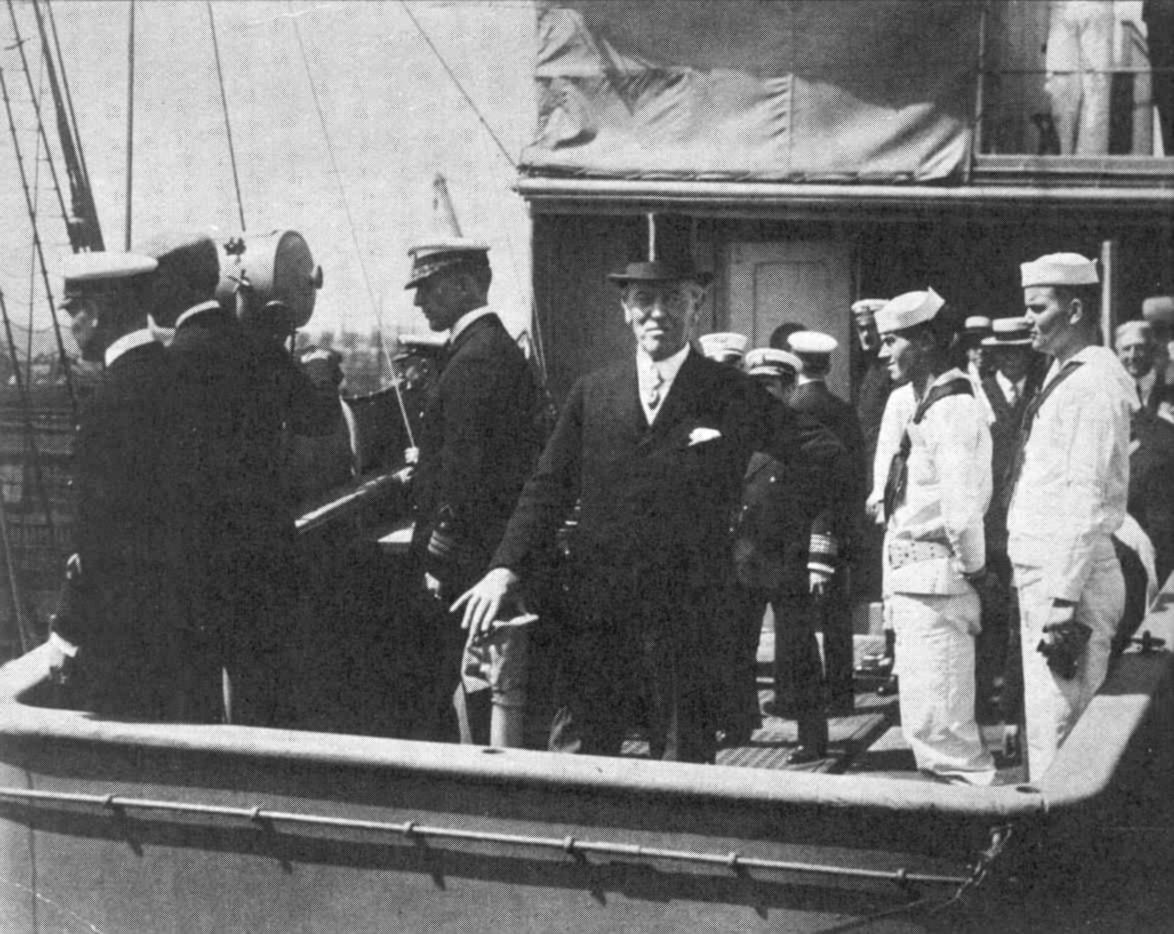
Woodrow Wilson leaving for
the Peace Conference in France
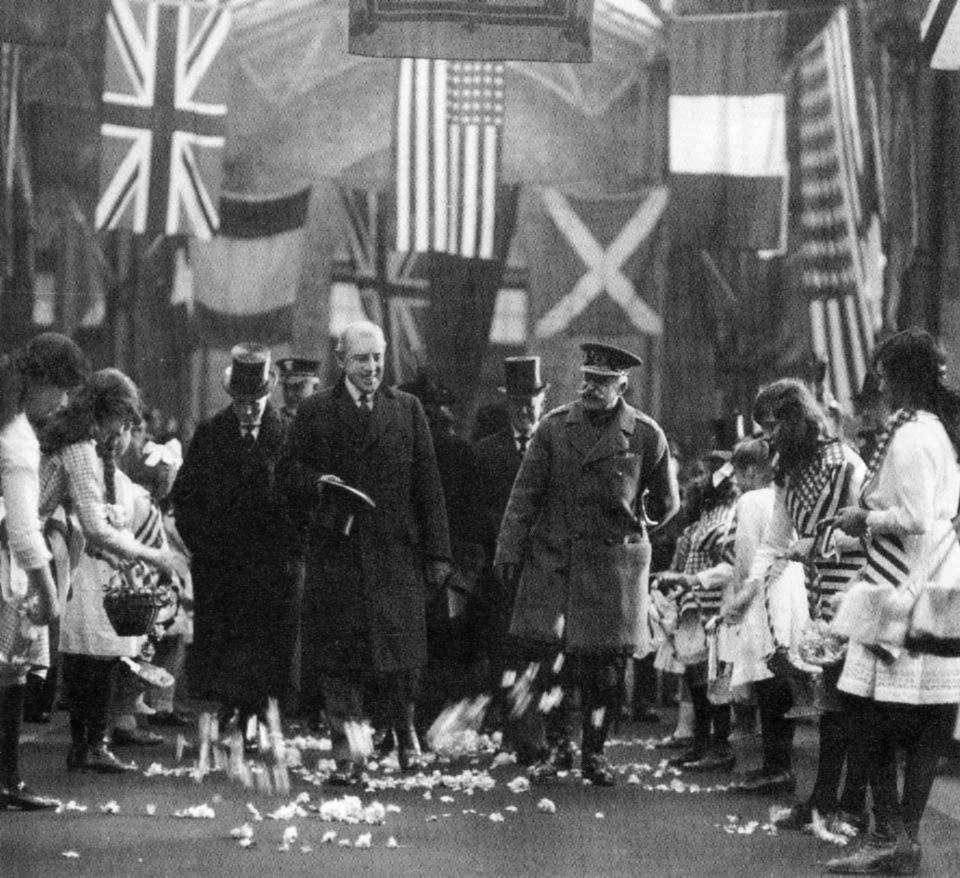
Wilson being hailed upon
his arrival in England
National Archives
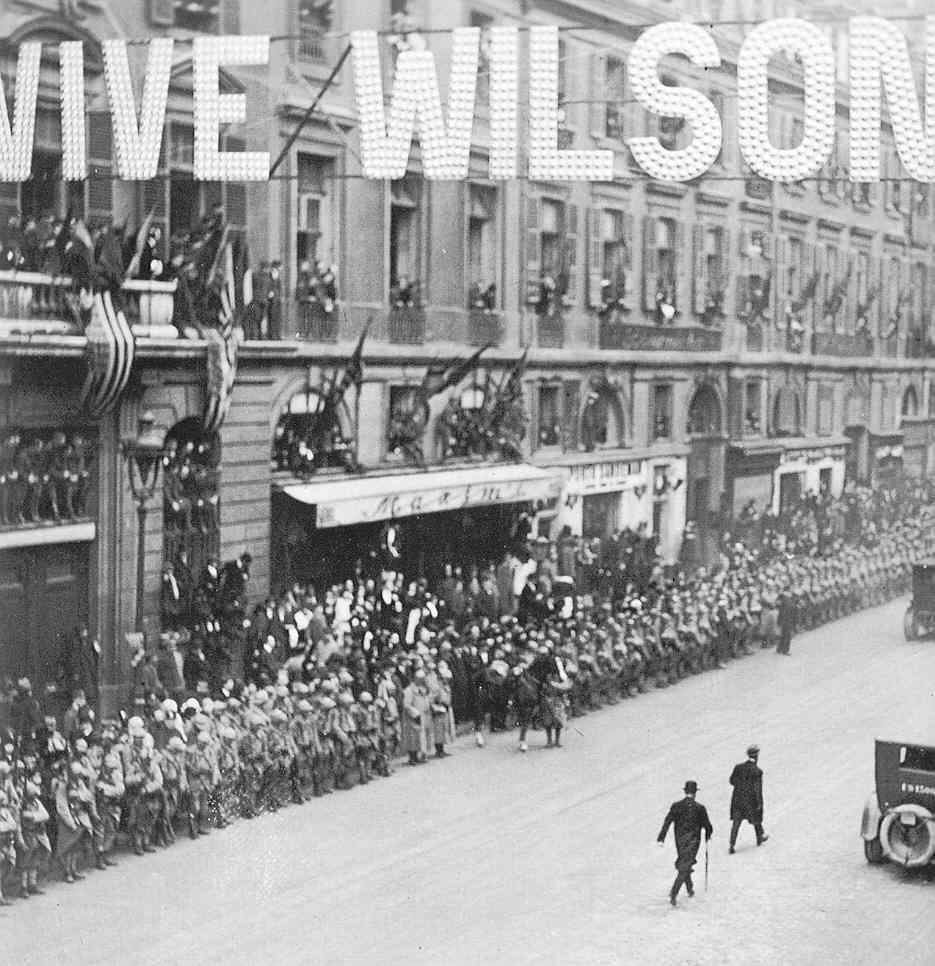
The Paris crowds waiting
for President Wilson
National Archives
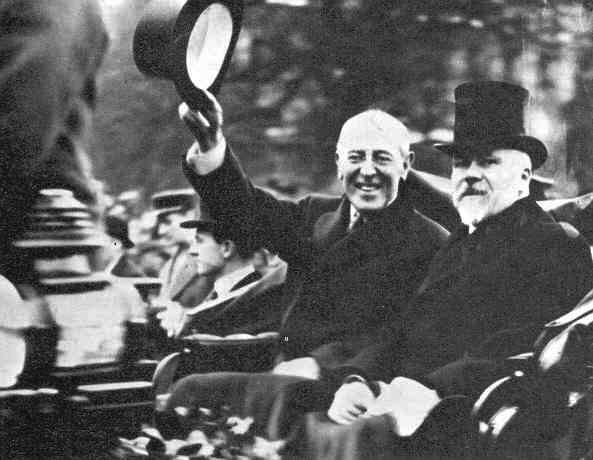 Paris - Wilson and
Poincaré
Paris - Wilson and
Poincaré
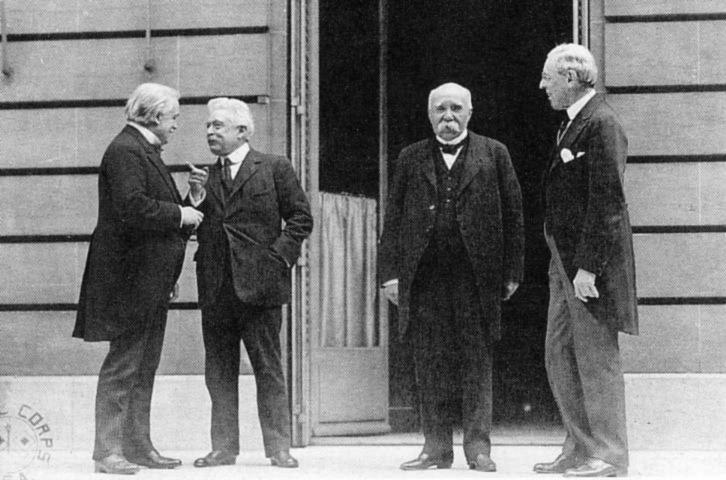 The Paris Big Four:
David Lloyd George, Vittorio Orlando, Georges Clemenceau and Woodrow
Wilson
The Paris Big Four:
David Lloyd George, Vittorio Orlando, Georges Clemenceau and Woodrow
Wilson
National Archives
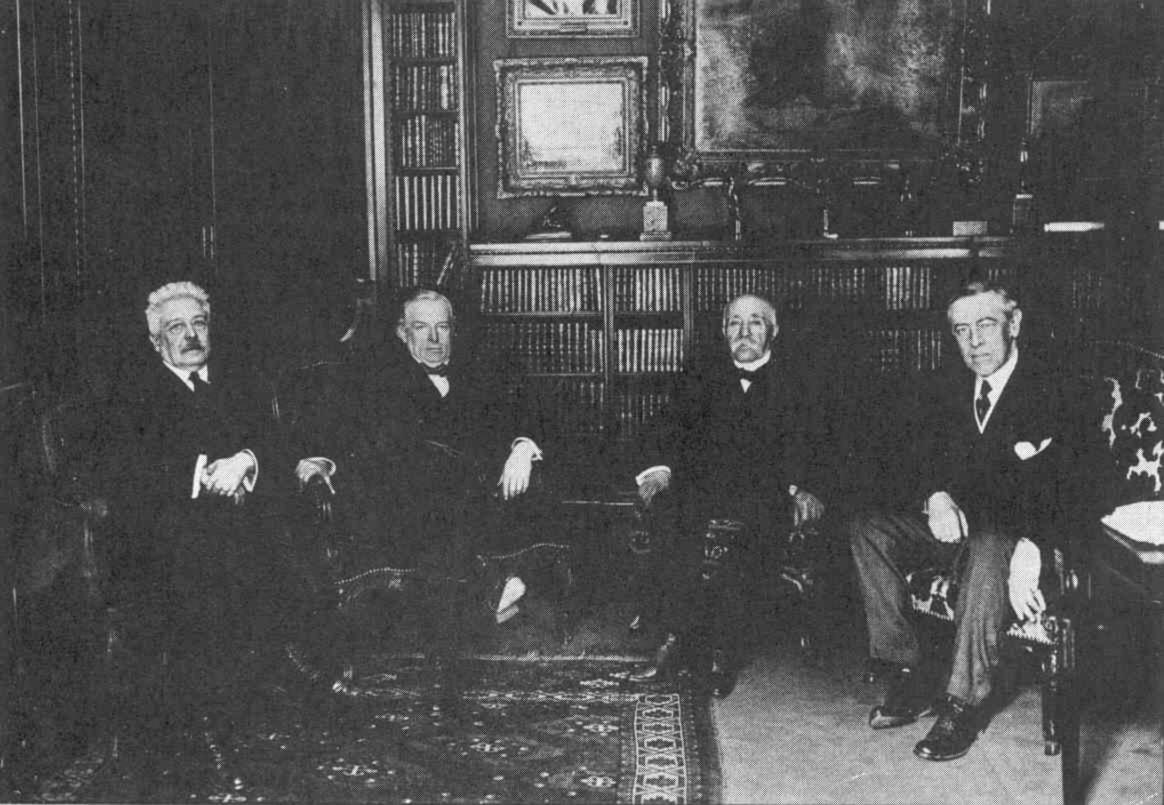
Orlando, Lloyd-George,
Clemenceau
and Wilson
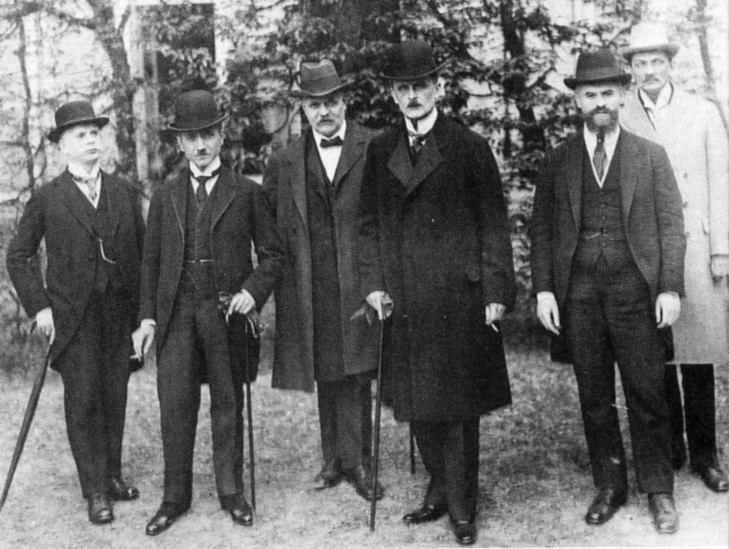 The German delegation at
Versailles - 1919
The German delegation at
Versailles - 1919
National Archives
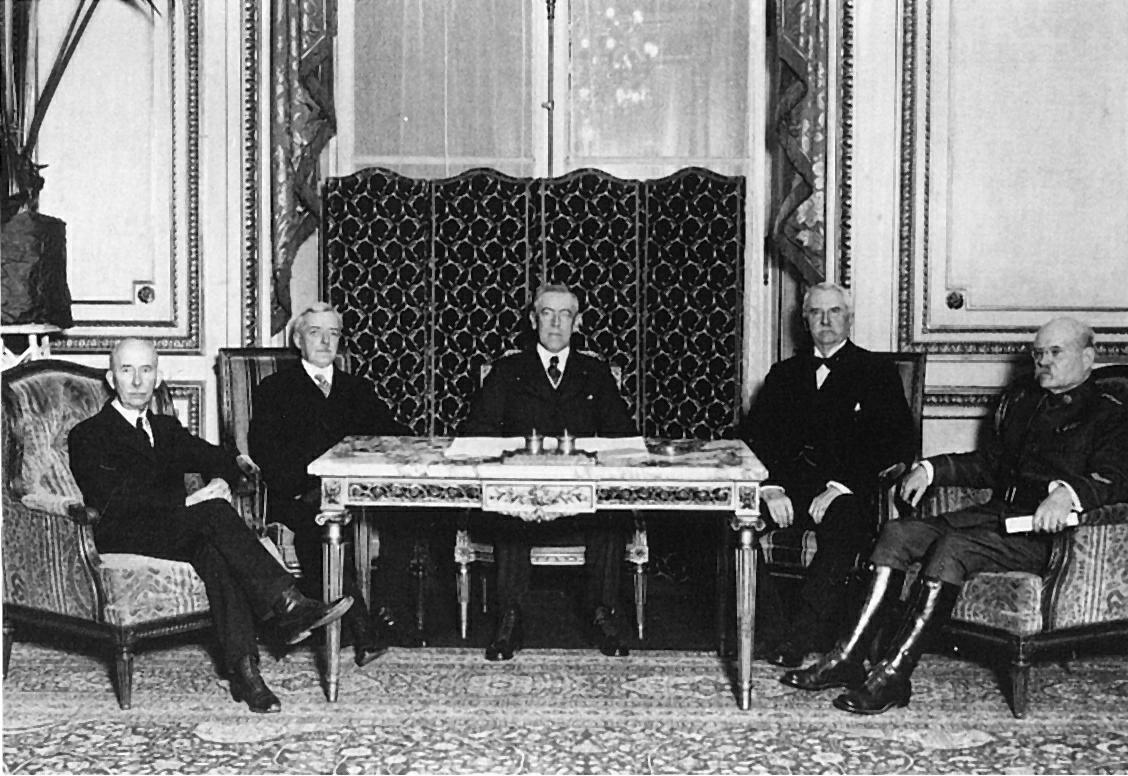
Wilson and the American
Delegation
at Versailles - 1919
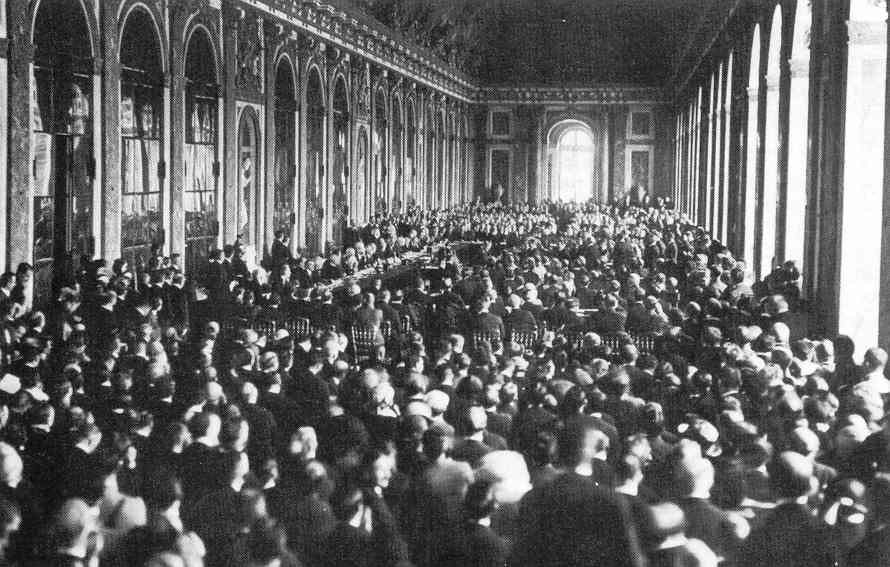
The signing of the peace
treaty at the Palace of Versailles – June 28, 1919
National Archives
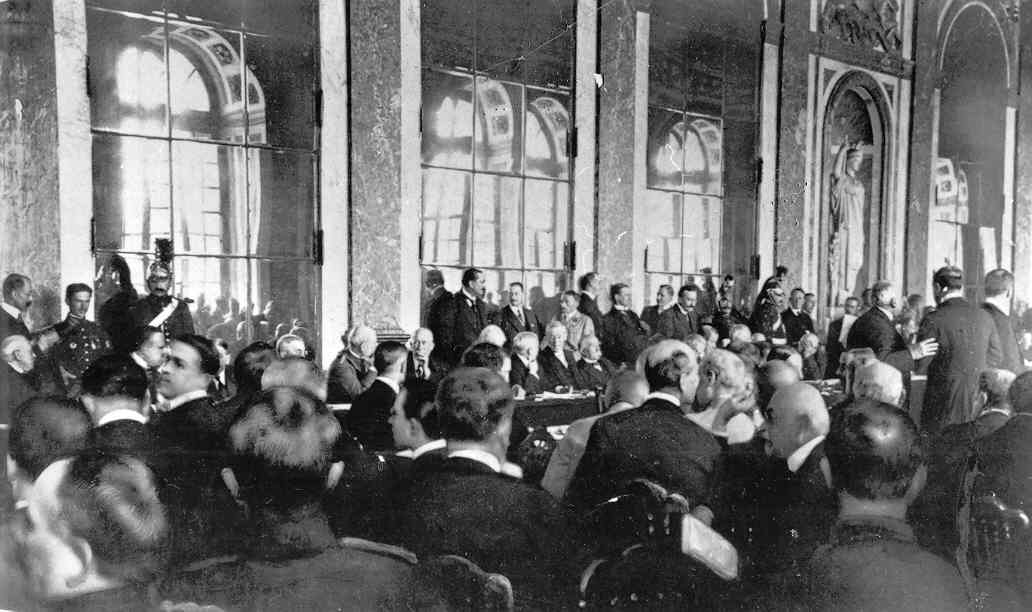
The Signing of the Treaty
of Versailles
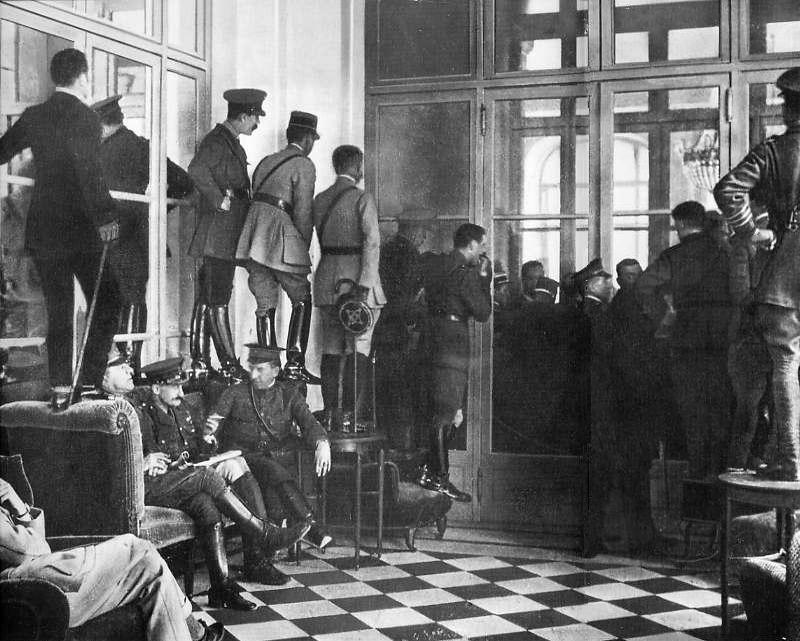 Spectators craning to see
the German signing of the Versailles Treaty - June 28, 1919
Spectators craning to see
the German signing of the Versailles Treaty - June 28, 1919
The territorial changes resulting from the post-war treaties
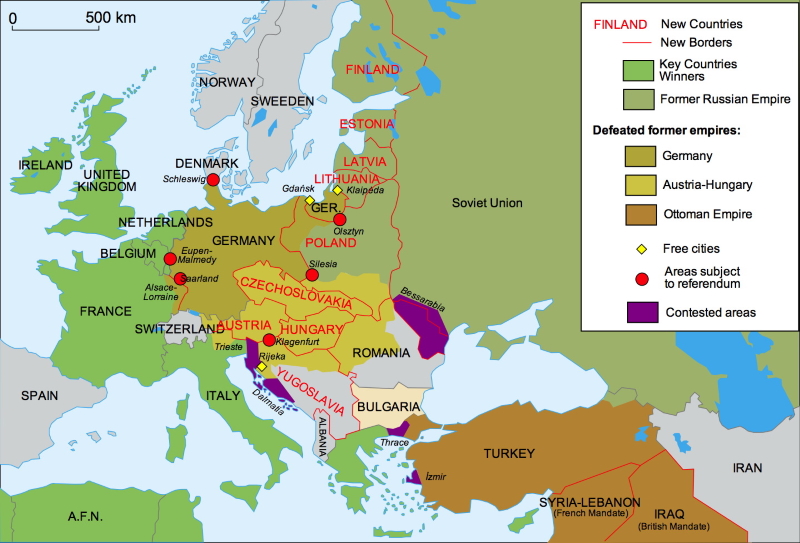
Europe after World War One
- 1923
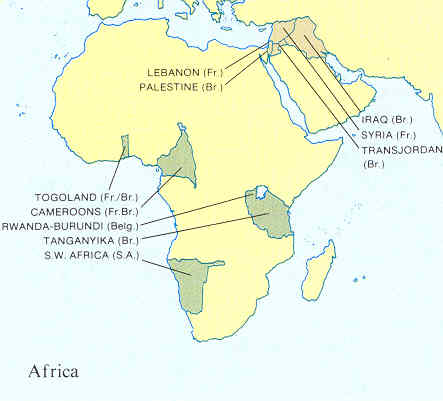
German colonial territory
in Africa and the Pacific and Turkish imperial holdings
in the Middle East lost after World War
One
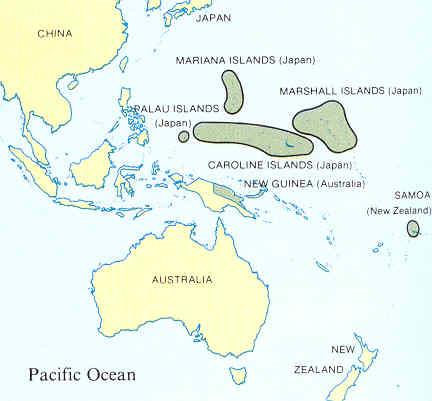
Wilson
himself was extremely unhappy at how the ‘peace’ went ... but held
fiercely to one hope: the Allies’ acceptance of (or covenant with) his
new League of Nations, an international organization that would bring
the nations together in diplomatic discussion before problems should
evolve to the point of disaster such as had been the case in the
startup of this recent war. Wilson was convinced that had there been
such an organization in 1914 the world would have been spared the
horror of this war.
Most importantly he hoped that once nationalist passions settled down,
cool headed diplomats could use the League to revisit these treaties
foisted on the war-wearied Central Powers and amend them in order to
produce a more just outcome, one that would remove the temptation of
the losers in this war to seek revenge in another war. Not being
able to back off the vengeful Allies in terms of the treaties, he
relied at least on their acceptance of the League to give him something
to bring home to America to show that its effort in the war had not
been wasted.
But in fact he came home to an America so burned by the behavior at
Versailles that it viewed with deep suspicion any kind of further
involvement in international affairs, much less European affairs ...
especially when it looked as if Wilson’s proposed League of Nations
might possibly take away from Congress and the nation the sovereign
right to decide for itself the nation’s particular stand on
matters of war and peace. Thus when the treaty was put
before the Senate for ratification it was defeated by a vote of 55 to
39.2 Further efforts to get it passed failed ... and eventually
the matter was dropped. Thus not only did the US not formally
recognize peace between itself and Germany3 ... it would not be joining
Wilson’s League of Nations (also part of the rejected Versailles
treaty).
But
forty-four nations did sign the League's Covenant in June of 1919 and
then set up an international organization headquartered in Geneva,
Switzerland. It included a League Assembly – where all the
members had a voice. But it also included a League Council –
where four "Permanent Members, Britain, France, Italy and Japan
(America was originally expected to be its fifth Permanent Member) were
joined by four (ultimately ten) other members rotated among the rest of
the League membership … this smaller body to take on the more sticky
diplomatic matters as the "enforcers" of League policy. As
matters brought to the Council for action were considered to be of a
much more critical concern, decisions of the Council had to be fully
unanimous ... except in cases where one of the members of the Council
was involved. That nation was not entitled to vote on the matter.
Besides
these representative bodies, there existed in Geneva a full-time staff
or Permanent Secretariat to oversee the League’s business on a daily
basis. These were bureaucracies authorized to act on a
number of particular issues – such as health, education, labor, women's
rights, the drug trade, slavery and other such social questions ... all
very much in keeping with the rising spirit of Socialism in Europe (and
Progressivism in America) in the early 1900s.
The League was
also empowered to supervise a Permanent Court of International Justice
(PCIJ) located in the Hague (the Netherlands) – a world court designed
to try cases involving international law. Bringing cases before
the PCIJ occurred frequently during the 1920s ... most concerning
boundary questions raised by the treaties ending the Great War.
But as matters became darker and more bitter in the 1930s, the PCIJ was
involved less and less in the developing political dynamics.4
As long as these issues did not involve directly any of the major
powers, they were settled more or less peacefully and equitably ...
because it was in the interests of the major powers to see these issues
resolved in this manner. But when the major powers were
themselves involved, things did not work out so well ... often with one
or another of the major powers resigning from the League in
protest.5
Thus the Wilsonian dream (and the dream of others like
him) that a realm of reason could override narrower social interests
proved to be exactly that: just a dream. Nationalist power
considerations still prevailed in the international realm.
2The vote fell eight short of the required two-thirds vote needed for the Senate's approval of any U.S. treaty.
3It would do so in a separate treaty with Germany in 1921.
4The
PCIJ was nonetheless highly respected and was one of the several League
organizations that was carried over as part of the new United Nations
when it was set up in 1945.
5The
PCIJ was nonetheless highly respected and was one of the several League
organizations that was carried over as part of the new United Nations
when it was set up in 1945.
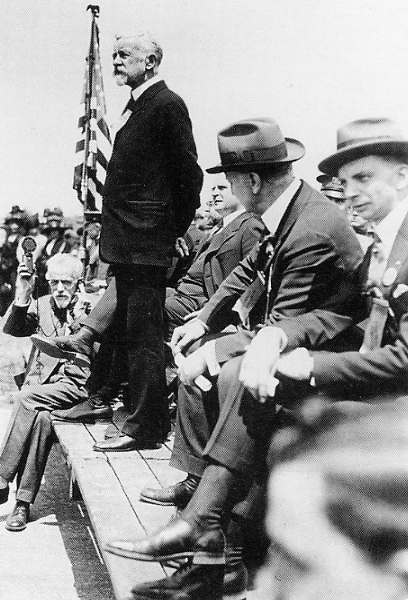 Senator Henry Cabot Lodge
(Chair of the Senate Foreign Relations Committee)
Senator Henry Cabot Lodge
(Chair of the Senate Foreign Relations Committee)
Library of Congress
LC-USZ62-96172
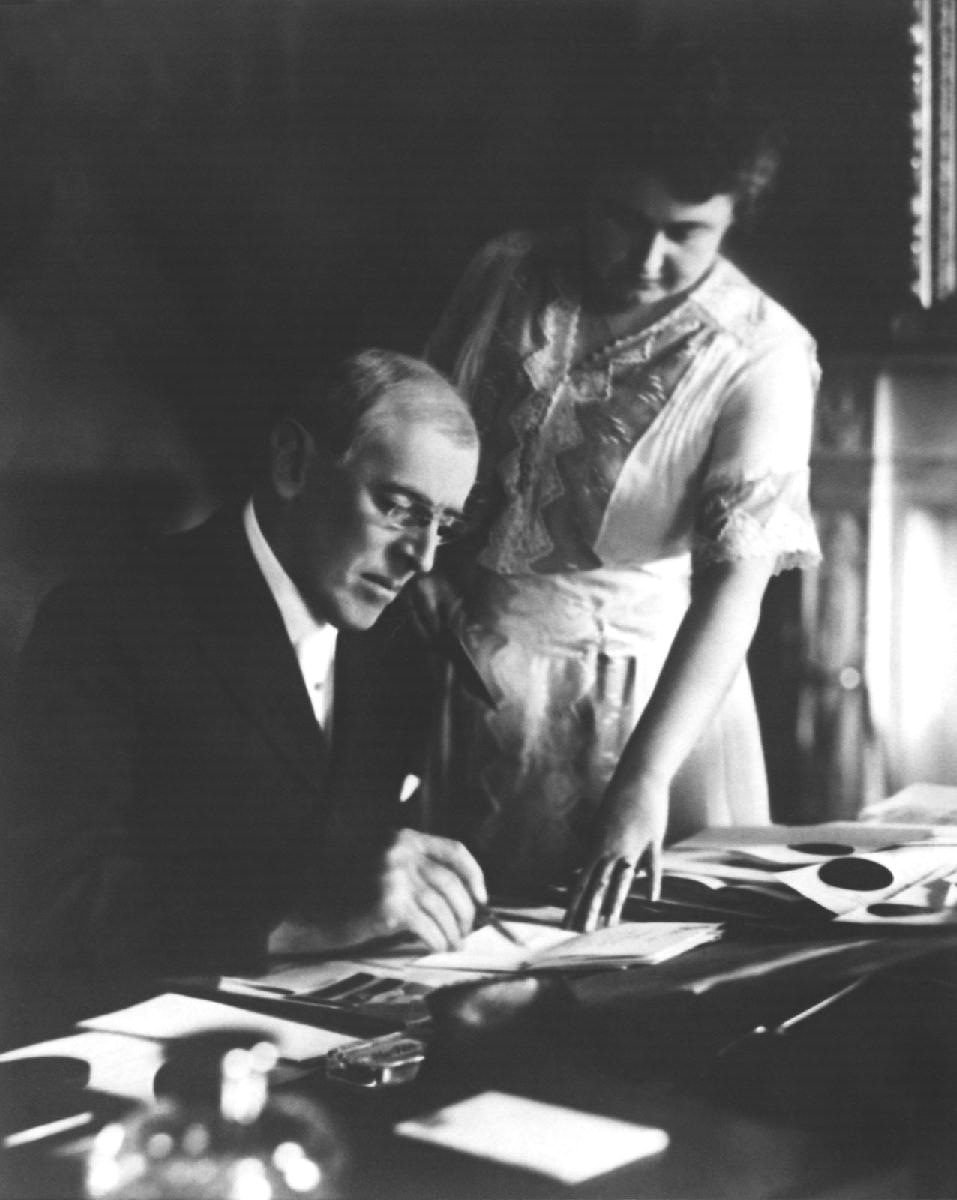
President Woodrow Wilson,
seated at desk with his 2nd wife, Edith Bolling Galt Wilson, standing at his
side. He was paralyzed on his
left side, so Edith holds a document steady while he signs - June 1920.
Library of Congress
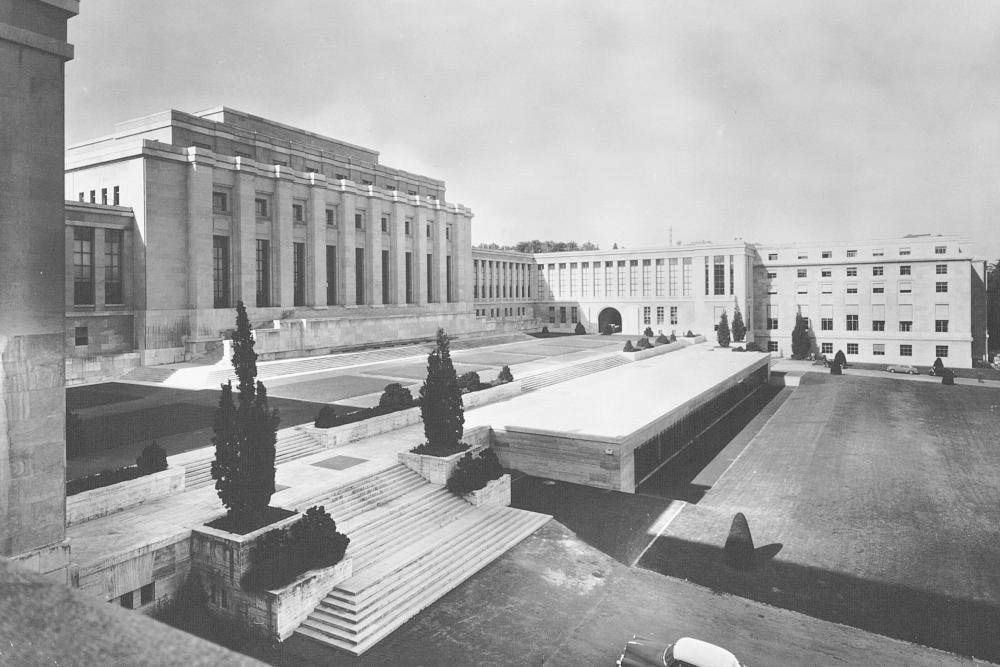
The League's Palace of Nations - Geneva
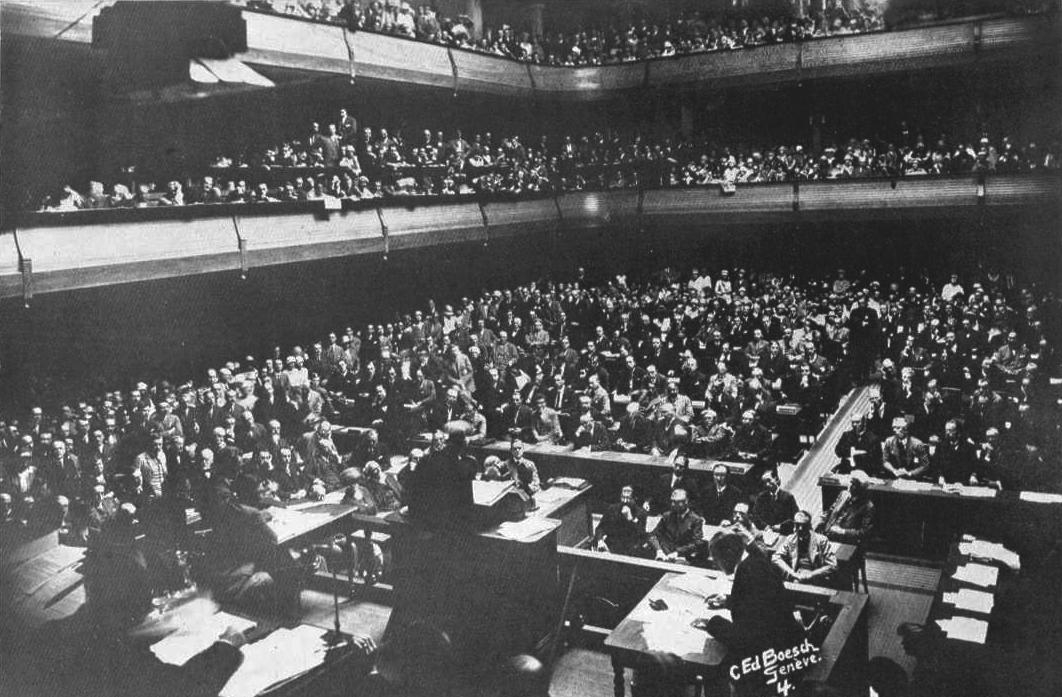
The September 10, 1926
meeting of the
League of Nations on the occasion of Germany's
entry into the
League. Foreign Minister
Gustav
Stresemann of Germany is addressing
the Assembly with his initial
speech.
THE POLISH-SOVIET WAR (1919-1921) |
Poland
was restored as a nation by taking sections from defeated Germany and
Austria-Hungary ... and also a huge section of the former Russian
empire that had been given over to Germany as the price of Russia’s
armistice with Germany and which now, despite Germany’s defeat, could
not be recovered by Russia because Russia was so completely distracted
by its intense civil war. The new Polish Republic’s Head of
State, Józef Piłsudski, a Polish Socialist and Poland’s leading wartime
military commander, sensed the fragility of the new Polish state,
especially with respect to the Russian lands it had acquired ... and
pushed for the expansion of its borders eastward into Russia to
increase its security. Lenin, on the other hand saw Poland as
directly in his path as he planned to spread or at least link up with
the communist revolutions to the west in Germany, Hungary and other
places in Europe where revolution seemed imminent. Sensing that
the Russians were about to invade Poland, Poland decided to strike
first.
Initially the Polish were largely successful, especially as they headed
their expansion toward Ukraine to the southeast (the April 1920 ‘Kiev
Offensive’). But as the Bolsheviks began to secure more control
in Russia (the Polish attack actually generated a new sense of Russian
patriotism supportive of the Bolsheviks) the Russians were able more
effectively to counter the Polish expansion ... and even by late May
begin to reverse course. By July the Polish troops
were in full retreat. And by August Lenin’s Russian troops were
just outside the Polish capital Warsaw.
With Poland seeming about to collapse, political disorder begins to
infect all parties involved, domestically and internationally.
Piłsudski’s opponents at home made their move against him adding to the
Polish panic. The Poles turned on the large Jewish community,
seeing it as an ally of Russian Bolshevism. British Prime
Minister David Lloyd George’s reluctant effort to send military aid to
Poland by was met by the threat of a general strike by the pro-Soviet
Trades Union Congress which succeeded in blocking any arms
shipments. Instead a threat was issued to Russia that Britain
would intervene on Poland’s side if the Russians did not pull back to
the Curzon Line (outlined in December 1919 by Lord Curzon who attempted
to define actual ethnic boundaries between the Polish and the
Russians). The Russians ignored the threat. And the British
Labour Party, which was also blocking shipments to British troops still
in Russia trying to help the Whites, announced that they would do so as
well for any attempt to help Poland. The French, for their part,
sent a small military party as advisers to the Polish army ... and
tried also to send an army of mostly Polish expatriates to France –
which the Czechs refused to let pass through their country.
But at this point a dispute erupted between Soviet Generals
Tukhachevsky and Yegorov, and Soviet General Budyonny (and seemingly
also Soviet Commissar Joseph Stalin) decided to fight the Poles at
Lwów, rather than join their fellow generals at Warsaw ... and the
Russian effort at Lwów failed miserably. Now things began to turn
against the Soviets. Polish General Sikorski now took to the
offensive (August) and with Piłsudski joining him the Russian army was
thrown into disarray, with the Russians retreating deep into Russian
territory. At this point the Russians were ready to negotiate ...
with the Poles holding the decided advantage. But the Poles
themselves were exhausted and ready to end hostilities ... and the
League of Nations was pressuring Poland to settle. But it was
Polish domestic politics that settled the matter when Piłsudski’s
enemies forced him to give up territory (leaving a million Poles within
the Soviet Union ... to face subsequent persecution from the Bolshevik
authorities). Likewise, Piłsudski’s Ukrainian allies were also
left in Bolshevik hands ... with sad results. Thus in March of
1921 the Peace of Riga was signed between Poland and Russia, officially
ending the war.
Nevertheless the Polish-Soviet War did the West a great favor in
shutting down Lenin’s plans for a grand Soviet revolution throughout
Europe (industrial workers across Europe supported strongly just such a
revolution). It would inadvertently play also a role in the
contest for control of the Soviet Union between Trotsky and Stalin ...
fought over the issue of whether the Russian revolution was merely a
starting point for an even greater European revolution (Trotsky) or
whether the Bolsheviks should now simply look after “socialism in one
country,” Russia (Stalin). The war with Poland greatly
strengthened Stalin’s argument! But it also helped the newly
established countries of central Europe secure their independence ...
especially Lithuania which Lenin was planning to absorb – before Russia
lost its war with Poland. And the war brought forward Piłsudski
as Poland’s national hero and once again future leader ... and also
French military advisor Charles de Gaulle and Polish General Władysław
Sikorski, both of whom would lead their national armies during World
War Two.
|
THE GRECO-TURKISH WAR (1919-1922) |
Meanwhile,
further to the south, the carve-up of the defeated Ottoman Empire
created a range of social dynamics that disrupted, confused and nearly
collapsed any semblance of a post-war social order within what was left
of the Ottoman Empire. In the Turkish political heart of the
empire a deep split occurred between Ottoman authority (the autocratic
rule of the Ottoman Sultan/Caliph and his conservative supporters) and
a rising breed of Turkish revolutionaries descended from the Young Turk
mentality.
In many ways what broke out in Turkey resembled closely what had broken
out in Russia. Indeed, Lenin and his Bolsheviks would be key
supporters to the Turkish Nationalist Movement ... ultimately led by
the hero of Gallipoli, Mustafa Kemal ... soon to be given the title
Atatürk, roughly equivalent to "Father of the Turks."
A big part of what inspired the Turkish Nationalist Movement was the
humiliating way the Sultan bowed to the dictates of the victorious
allies ... and how he allowed the near total takeover of Ottoman lands
by their wartime enemies. In part it was also motivated by the
idea that if Turkey did not modernize in every social respect possible
(economy, education, even world view, as well as politics and military)
Turkey would remain a victim to the whims of their occupiers.
Thus soon after the war ended Turkey found itself in a state of
domestic turmoil as the traditionalists and the modernizers fought each
other for control of Turkish society.
The conflict between the two Turkish parties actually broke out in the
summer of 1919 when a conference was called by the revolutionaries to
begin the process of modernizing Turkish society from top to
bottom. They also created a negotiating team to meet in Paris
with the Allies in order to give stronger representation to Turkey,
hoping to counter the weak representation the Sultan’s emissaries had
given the Turkish empire. That fall they moved to set up a new
government at the city of Ankara in the Turkish heartland ... in
opposition to the Sultan and his weakened government in
Constantinople. In short, Turkey now had two governments.
At the same time similar activities were going on among the Greeks, who
had joined the Allies under the promise by British Prime Minister
Lloyd-George of the further expansion of Greek territory as a reward
for Greek participation. The Greeks were led to believe that
their country would be expanded against Ottoman holdings not only in
the Balkans but also in coastal Asia Minor and the Anatolian interior
as well. The coastal regions of Asia Minor had anciently been
quite Greek – but over the more recent centuries had been heavily
re-cultured along Turkish-Muslim lines. Nonetheless, almost 20%
of the population of Asia Minor/Anatolia was still Greek Christian in
language and religion. A Greek community of some size existed
along the coastal regions of Asia Minor around the city of Smyrna – and
the Greeks probably rightly feared for their safety against Turkish
ethnic hostilities encouraged by the strongly Turkish nationalist Young
Turks (Christian Armenians had suffered horribly during the war at the
hands of the Young Turks and their Turkish nationalist
supporters). Also the spirit of Greek nationalism ran strong –
with the hope that even the ancient center of Greek or Byzantine
culture at Constantinople (Istanbul) might be restored to the Greeks.
Unfortunately, as was frequently the case, the Allies had made offers
to other national groups (such as the Italians) that were destined to
conflict with the post-war picture that had been presented the
Greeks. Within Greece itself the question of getting involved in
the war at all also had badly split Greek politics. The liberal
political leader Venizelos was much in favor of joining the Allies
whereas King Constantine was fearful of the consequences of such
involvement and stood firm in his intention to keep Greece a neutral
nation. In the end Venizelos won out, King Constantine was
deposed (his son Alexander taking the throne, but being basically a
puppet to Venizelos), the Greeks joined the Allies, and at war’s end
Greece was looking forward to building a greater Greece that resembled
the territorial reach of Greece thousands of years ago.
But the Italians, who partially as descendants of the once great Empire
of Venice, were also looking forward to seeing Italian power extended
deep into the Eastern Mediterranean ... and into the Asia Minor
peninsula (roughly today’s Turkey) as well, a matter which now required
the negotiators in Paris to handle matters very carefully (the Italians
were already upset that they were not getting what they expected on the
eastern shore of the Adriatic Sea ... and had even left Paris in a huff
for a while!). Also Britain and France had their own plans for
the Ottoman Empire, not just in setting up puppet Arab Kingdoms but
even in the occupation of the Asia Minor peninsula and even the capital
Constantinople itself. The Turks consequently were left to rule
on their own only a tiny portion of what had once been a great empire.
This is what decided Venizelos to push from the Smyrna region of
western Asia Minor that had finally been allocated to the Greeks
eastward, deeper into Asia Minor. He was counting on the support
of the Allies ... or at least the British, which he did get, though not
greatly. In May of 1919 the Greeks made their move by landing
twenty thousand Greek soldiers at the port city of Smyrna. From
there the Greek troops, encountering only rather light or disorganized
Turkish resistance, began spreading their zone of control towards the
east, into the Anatolian interior. By August of 1920 the
government of the Turkish Sultan was ready to agree to terms of a full
treaty (the Treaty of Sèvres) ending for them their part in the Great
War. The treaty was extremely generous to Greece – and very
humiliating to Turkey.
At first the Greeks were greatly victorious in their encounters with
the Turks, who seemed unable to get a strong defense organized.
Deeper and deeper into Turkish territory the Greeks went, with the
Turks giving up position after position. All through 1920 the
Greeks registered success after success. But then King Alexander
died (bit by a monkey), Venizelos called a national election ... which
he then lost (most of the Greeks were very tired of all the warring
that had been going on under Venizelos). The opposition (strongly
Royalist in nature) called Constantine back to the throne ... throwing
into confusion the matter of the Greek expansion in Asia Minor.
Now things began to go wrong for the Greeks.
Twice in early 1921 the Greeks were thrown back by the fierce Turkish
resistance organized by their leader Mustafa Kemal (Atatürk). The
Italians, who had been jealous of the Greeks, and the French, who
considered the Greeks now merely British clients, began to throw their
support to Kemal’s Turkish forces. Also Russia was supplying the
Turks with important weapons in exchange for some territory it received
from the Turks.
Atatürk had taken over the Turkish defenses and pulled his troops back
across a river to heights overlooking the river. On came the Greeks ...
and found themselves up against a Turkish army determined to give no
more ground to the Greeks. The battle raged on and soon became
one of resupply. Finally the Greeks felt it was time to pull
back. But once the retreat got underway it never seemed to find a
point to dig in and halt. Now it was Atatürk’s troops doing the
pushing ... rapidly advancing against retreating Greeks. At this
point Greek civilians in the west of Asia Minor began to panic.
On came the Turks even finally to the last Greek stronghold at Smyrna
... and there crushed the last of the Greek resistance (and burned out
the Greek and Armenian sections of this huge city). By
mid-September (1922) the Greeks had lost everything.
The war was over – and a new treaty (Treaty of Lausanne) had to be
drawn up between Turkey, Greece, Britain, France and Italy. It
provided for the transfer of populations: 500 thousand Muslims to be
relocated from Thrace to Asia Minor and over a million Greeks from Asia
Minor to Thrace, Macedonia and Attica (Eastern Greece).
Considering the scale of the ethnic cleansing that had occurred on both
sides during this war (whole communities of Turks on the one hand and
Greeks and Armenians on the other were completely obliterated) this
transfer of populations, though cruel in execution, was preferable to
remaining behind and being slaughtered in the heat of the intense
Greek-Turkish hatred that now existed between these two people.
This definition of
"Turk" comes largely at the expense of what it means to be "Armenian (during the Great
War) or "Greek" (during the Greco-Turkish War of 1919-1922)
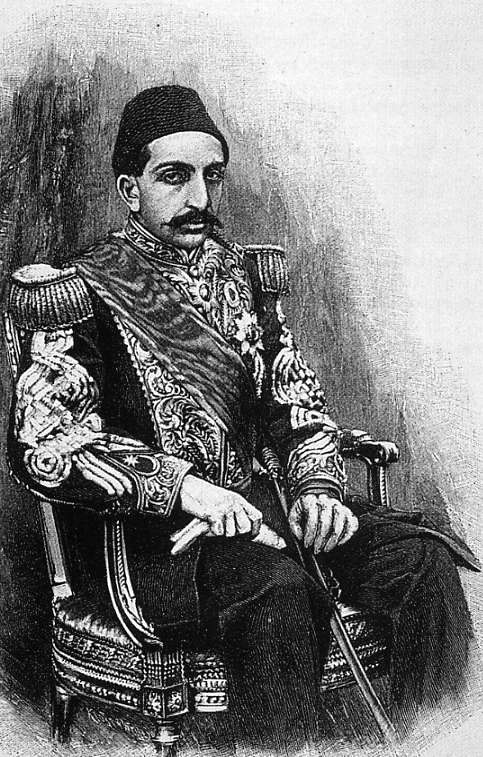
Ottoman Emperor Abdul Hamid
II (reigned 1876-1909). He was deposed by the
Young Turks in
1909 because they hated his weakness - but lived until 1918 just as the once-great Ottoman Empire
was being carved up by the World War I peace treaties
The Turks, both during and
after the War brutally refashion a sense of what it means to be a "Turk." In particular they vent
their powerful national feelings on a helpless Christian people - the Armenians
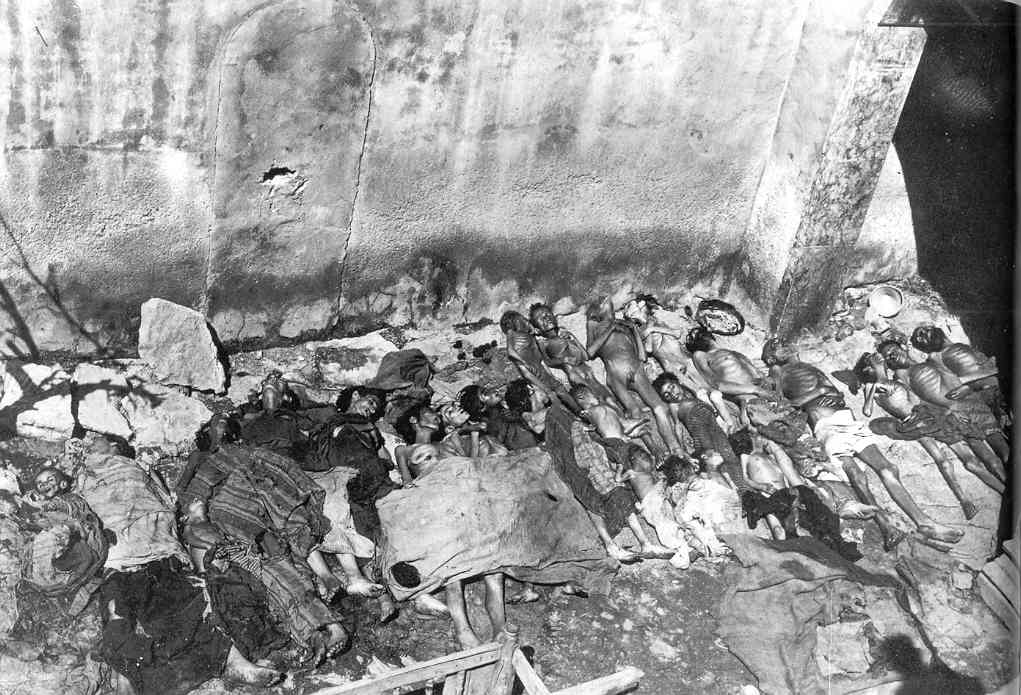
Armenians slaughtered by
the Turks - 1915
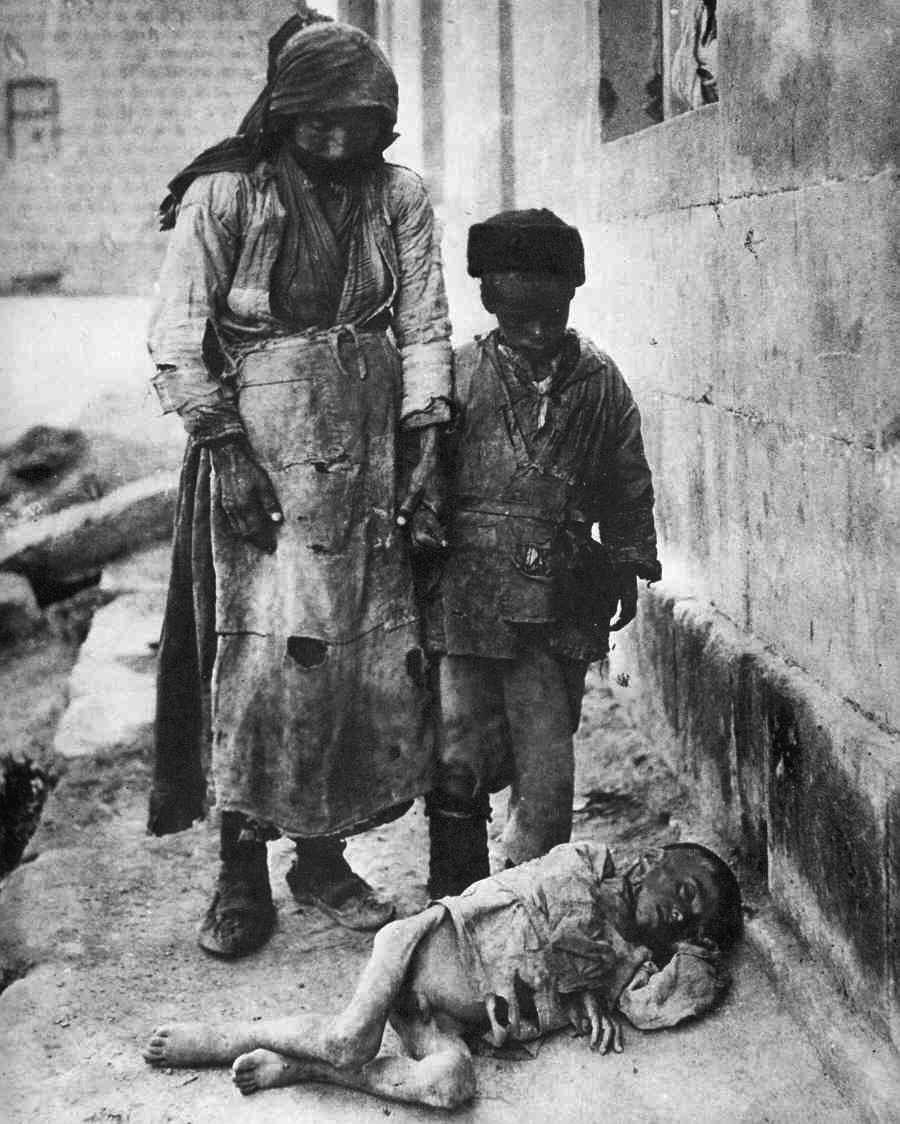
A starving child in Yerevan,
where the Armenians attempted to set up an independent republic after the War to avoid further
massacre by the Turks
The Greco-Turkish War of
1919-1922
The Greeks, sensing Turkish
weakness, decide to expand Greek territory from the Western
coastline (inhabited heavily by Greeks)
into the Anatolian interior of Asia Minor.
This will prove to be
a huge error.
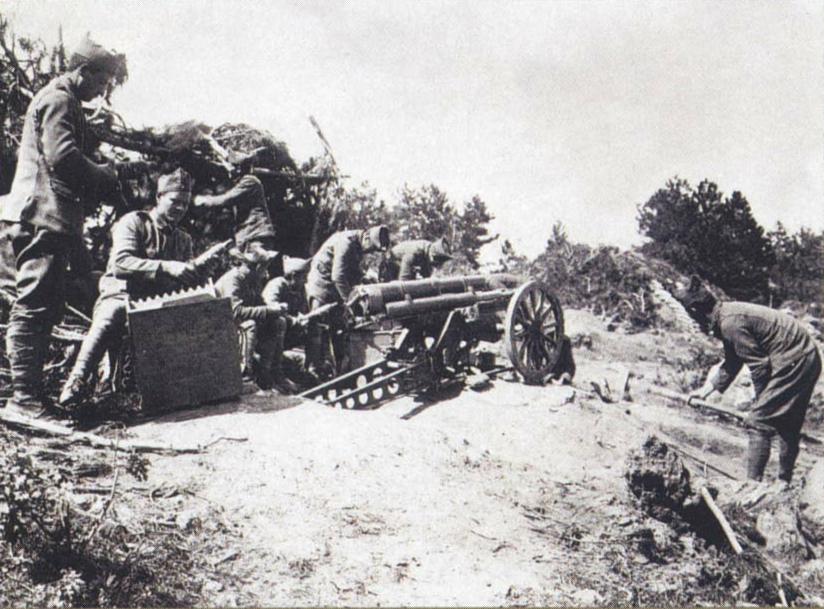 Greek artillery supporting
an infantry assault into Anatolia - August 1921
Greek artillery supporting
an infantry assault into Anatolia - August 1921
National Archives
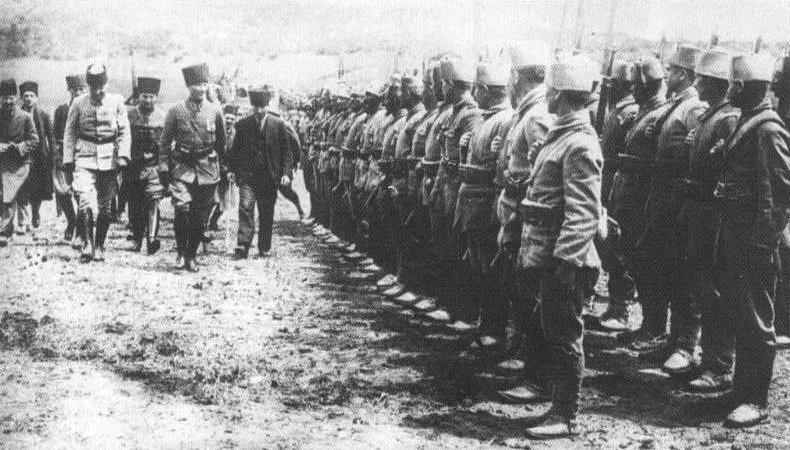
Mustafa Kemal (Turkish “hero
of Galipoli” during World War One) reviews Turkish troops at the outbreak of the Greco-Turkish
War. He will lead the Turks to a huge victory over the Greeks ... and will earn
for himself the title "Ataturk : "Father of the Turks"!
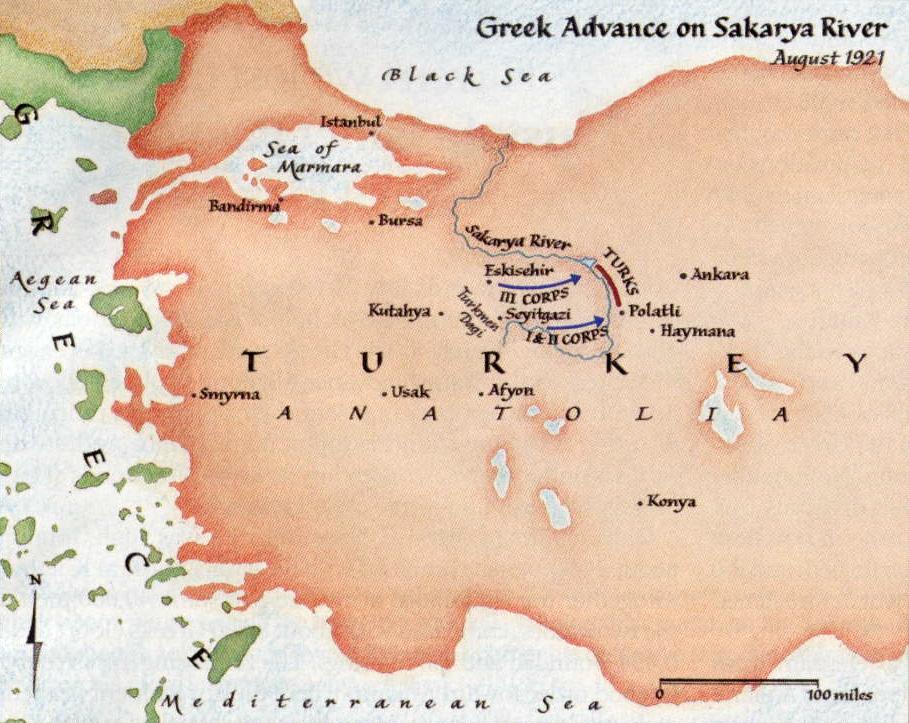
The Greek army's two-pronged
advance on the Sakarya River - August 1921. Ataturk drew his troops
back to a more compact line of Turkish defense across the river -- which would be the further
line of retreat before he began the Turkish advance against the Greeks
Joan Pennington
- Military History,
September 2006, p. 53
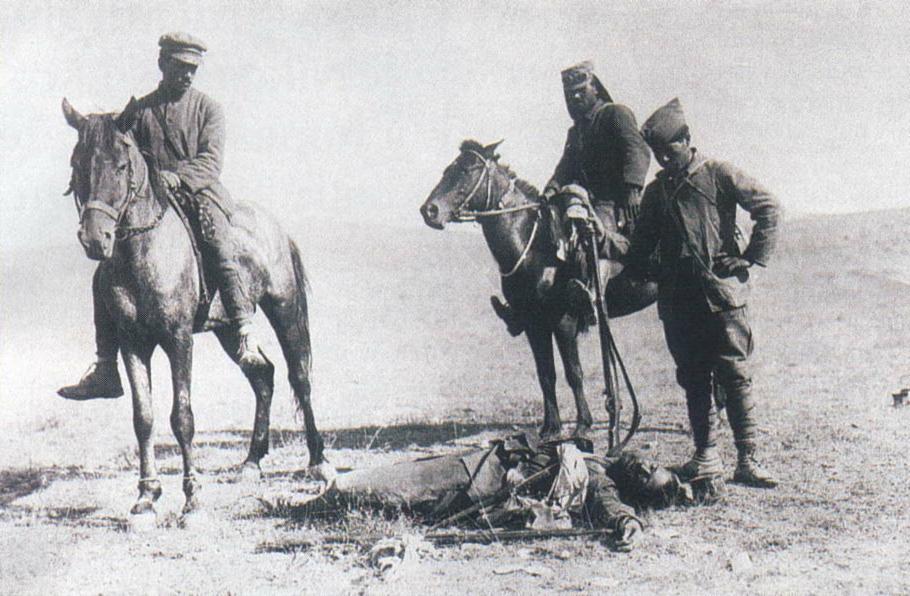
Greek troops stop before
a body of a Turk killed during their march to the Sakarya River
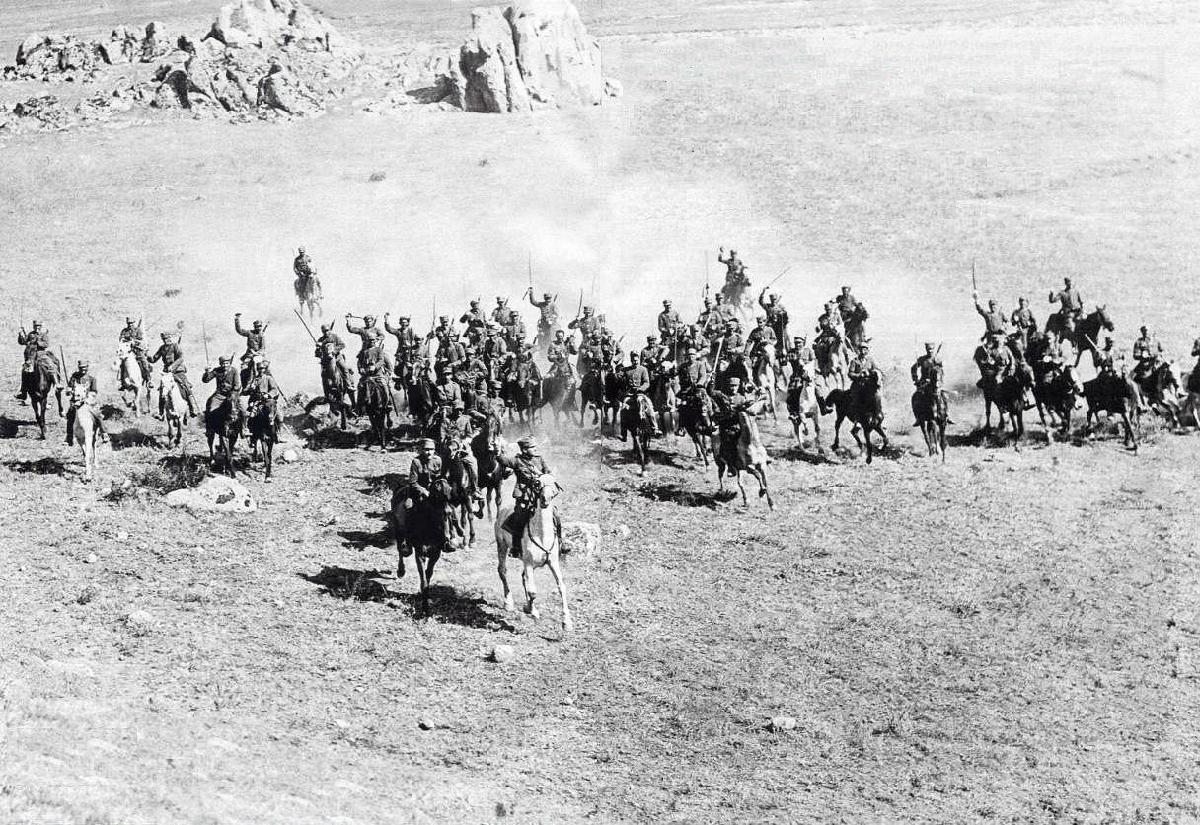
Greek cavalry trying to hold
back a Turkish advance toward the port of Smyrna - Sept. 16, 1922
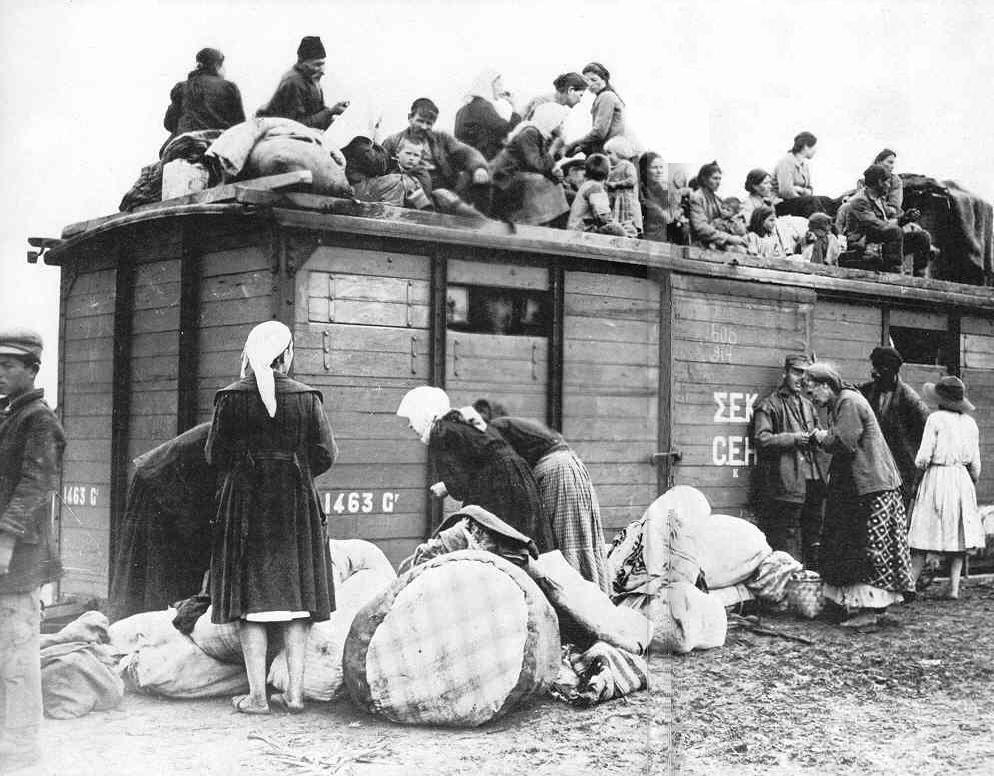
Greeks fleeing Turkey -
1922
Atatürk then moves on to modernize Turkey.
So completely taken was Turkey by Atatürk’s success, that the Turks
seemed most willing to follow whatever path he seemed to want to take
the country down at this point. And for Atatürk, that meant
modernization … deep modernization.
There was no real
opposition to his ending the Ottoman sultanate and replacing it with a
new Turkish Republic (1922-1923), with himself as the Republic’s new
president (1923-1938), voted there through universal male adult
suffrage … adding women’s suffrage to the dynamic in 1930.
He
also understood that if Turkey were to be able to protect itself fully
from Western intrusions, it was itself going to have to take on Western
ways – economically and culturally as well as politically. That
was not going to please Muslim traditionalists. But at this point
they had nothing to offer in opposition to Atatürk’s reforms.
Thus
Atatürk redesigned the Turkish written language … taking it from an
Arabic alphabet to a Latin-based alphabet. He took on Western
attire (the military had actually already done this) as a civilian
political leader … and extended this same updating in attire to women,
no longer forced to wear Islamic attire. Education would now be
conducted by public educators … rather than by the traditional Muslim
mullahs. And so it went with the "Kemalizing" of Turkey. |
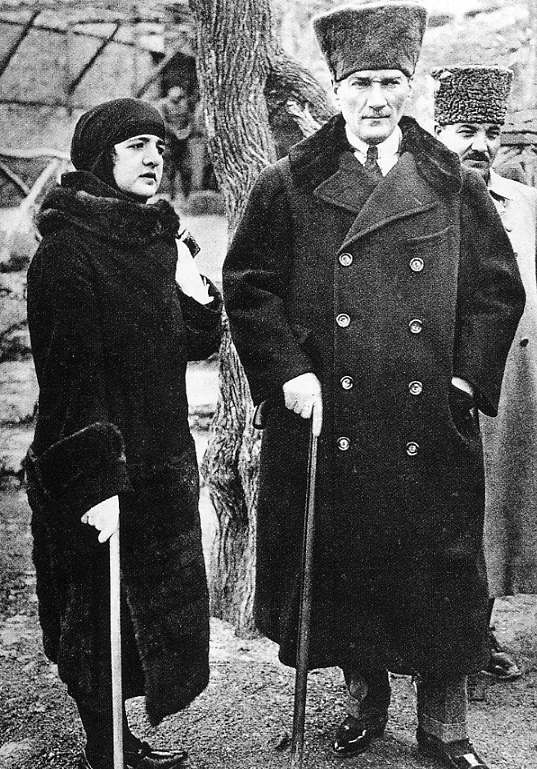
Mustafa Kemal Ataturk (1881-1938)
and his wife Latife Hanm. Now the undisputed leader,
Ataturk leads the country in a massive secular program of modernizing Turkish society
… something only he could have achieved
because of his huge
popularity | | | | |


 The brutal reality facing a post-war
The brutal reality facing a post-war Nationalism versus internationalism
Nationalism versus internationalism
 The Russian Civil War (1917-1922)
The Russian Civil War (1917-1922)
 The Polish-Soviet War (1919-1921)
The Polish-Soviet War (1919-1921)
 The Greco-Turkish War (1919-1922)
The Greco-Turkish War (1919-1922)





































































